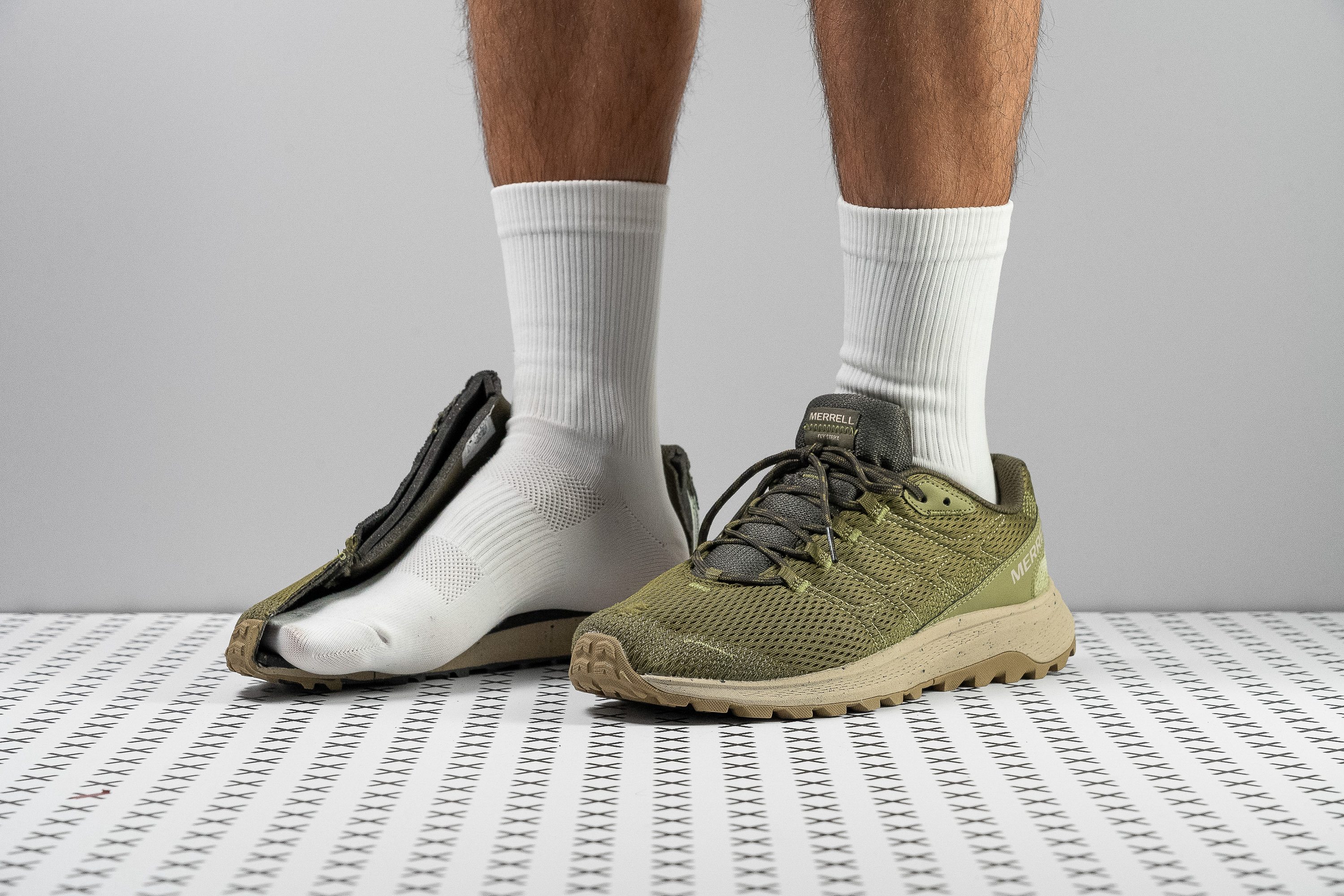Our verdict
- Top pick in best Merrell trail running shoes
- Top pick in best Merrell running shoes
Pros
- Great ventilation
- Durable and cosy upper
- Ultra-plush tongue
- Reasonably priced
- Suitable for casual wear
- Works well for walking and hiking
- Can be used as a go-to travel shoe
Cons
- Excessively high drop
- Only suited for heel strikers
- Lacks outsole durability
Audience verdict
Comparison
The most similar running shoes compared
+ + Add a shoe | |||||
|---|---|---|---|---|---|
| Audience score | 79 Good! | 83 Good! | 74 Bad! | 89 Great! | |
| Price | £100 | £135 | £100 | £130 | |
| Trail terrain | Light | Moderate | Light | LightModerate | |
| Shock absorption | - | - | - | Low | |
| Energy return | - | - | - | Moderate | |
| Arch support | Neutral | Neutral | Neutral | Neutral | |
| Weight lab Weight brand | 10.3 oz / 292g 10.4 oz / 295g | 9.6 oz / 271g 9.5 oz / 270g | 11 oz / 312g 11.5 oz / 326g | 10.3 oz / 291g 10.3 oz / 291g | |
| Drop lab Drop brand | 17.3 mm 10.0 mm | 8.9 mm 6.0 mm | 8.2 mm | 8.7 mm 8.3 mm | |
| Strike pattern | Heel | HeelMid/forefoot | HeelMid/forefoot | HeelMid/forefoot | |
| Size | True to size | Half size small | True to size | Slightly small | |
| Midsole softness | Balanced | Soft | Balanced | Balanced | |
| Difference in midsole softness in cold | Small | Normal | Small | Small | |
| Toebox durability | Good | Very bad | Decent | - | |
| Heel padding durability | Decent | Bad | Bad | - | |
| Outsole durability | Decent | Decent | Good | - | |
| Breathability | Moderate | Moderate | Moderate | Moderate | |
| Width / fit | Narrow | Medium | Narrow | Medium | |
| Toebox width | Wide | Medium | Medium | Medium | |
| Stiffness | Stiff | Stiff | Stiff | Moderate | |
| Torsional rigidity | Stiff | Stiff | Moderate | Moderate | |
| Heel counter stiffness | Moderate | Stiff | Moderate | Flexible | |
| Lug depth | 3.5 mm | 3.4 mm | 2.9 mm | 3.5 mm | |
| Heel stack lab Heel stack brand | 34.3 mm 27.0 mm | 29.3 mm 34.0 mm | 33.8 mm | 27.2 mm 29.6 mm | |
| Forefoot lab Forefoot brand | 17.0 mm 17.0 mm | 20.4 mm 28.0 mm | 25.6 mm | 18.5 mm 21.3 mm | |
| Widths available | NormalWide | Normal | NormalWideX-Wide | NarrowNormal | |
| Season | All seasons | All seasons | All seasons | All seasons | |
| Removable insole | ✓ | ✓ | ✓ | ✓ | |
| Orthotic friendly | ✓ | ✓ | ✓ | ✓ | |
| Ranking | #317 Bottom 14% | #263 Bottom 29% | #358 Bottom 3% | #107 Top 29% | |
| Popularity | #298 Bottom 19% | #199 Bottom 46% | #311 Bottom 16% | #147 Top 40% |
Who should buy
We believe the Merrell Fly Strike is an ideal choice for:
- Those dealing with calf or Achilles tendon issues, thanks to its massive heel-to-toe drop.
- Trail enthusiasts on a budget seeking an affordable, all-around shoe for diverse outdoor activities, from running to hiking.
- Those seeking a multipurpose trail shoe that transitions smoothly into casual settings, making it a great option for light travel.
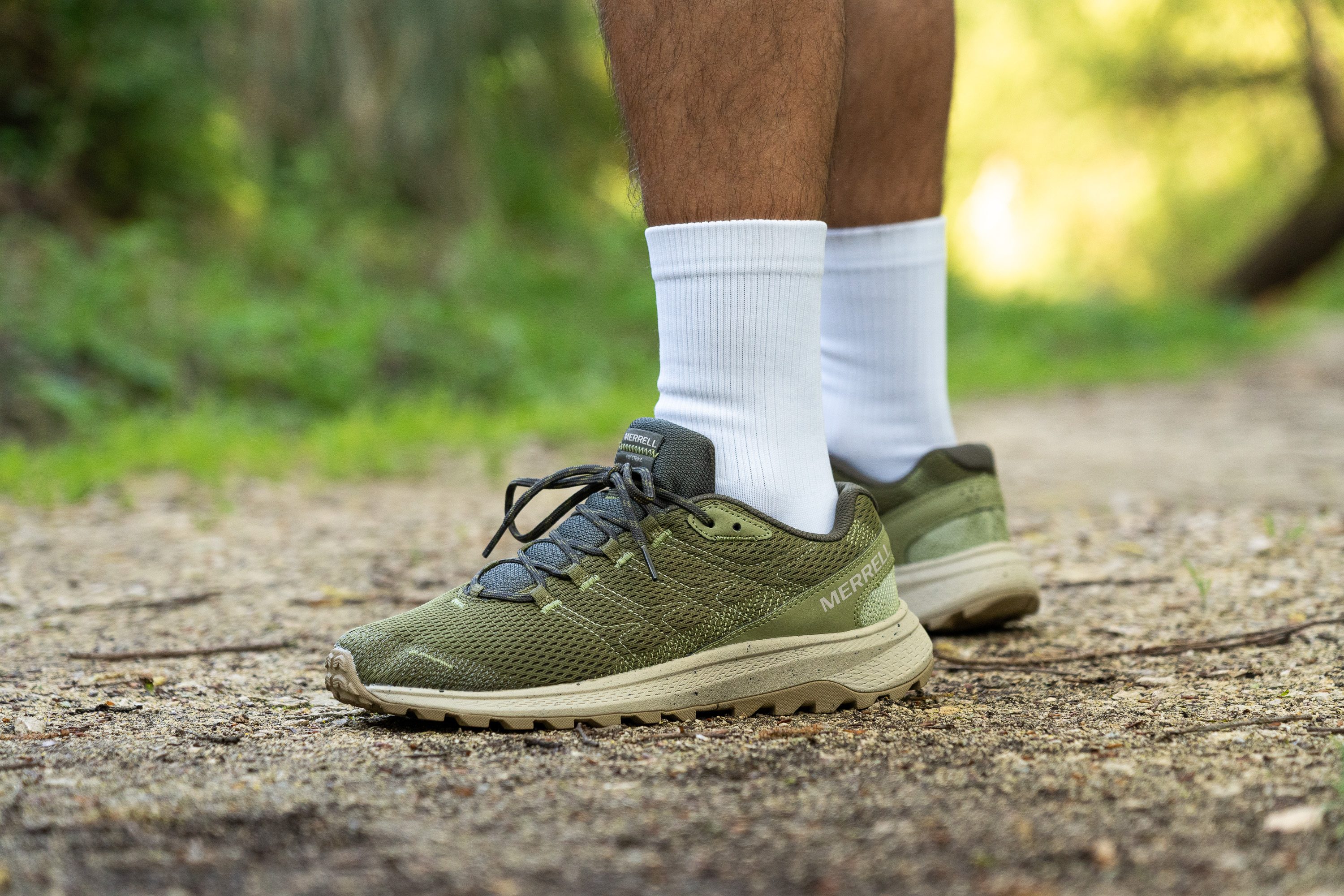
Who should NOT buy
We believe the Merrell Fly Strike, with its astonishing 17.3-mm drop, may not be the best fit for most runners, particularly for those accustomed to use shoes with less than a 12-mm offset.
This excessive drop, coupled with its minimal cushioning in the front, makes it a less-than-ideal choice for forefoot and midfoot strikers. For a more balanced option, we recommend the Nike Pegasus Trail 4, offering a still-high 12.7-mm offset at a reasonable price point.
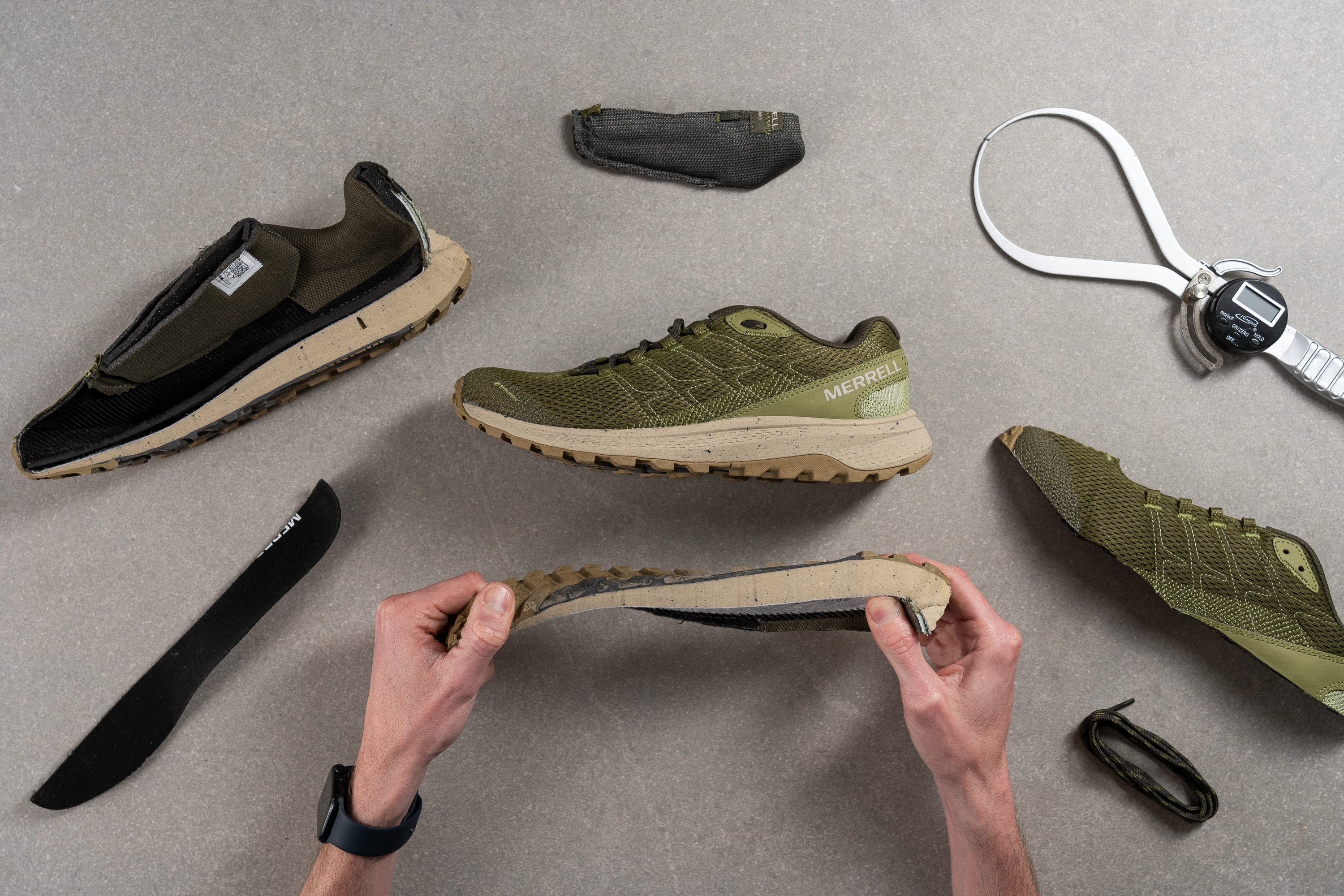
Furthermore, the Fly Strike's weight seems too much to us for its level of cushioning. For those loyal to Merrell but seeking more protection underfoot, the Agility Peak 5 presents a more cushioned alternative within the same brand. Meanwhile, in our view, the ASICS Gel Venture 9 stands out as the best versatile choice for budget-conscious trail runners.
Cushioning
Heel stack
In our lab, we measured the shoe's heel at 34.3 mm, providing ample cushioning to comfortably support long trail runs and hikes.
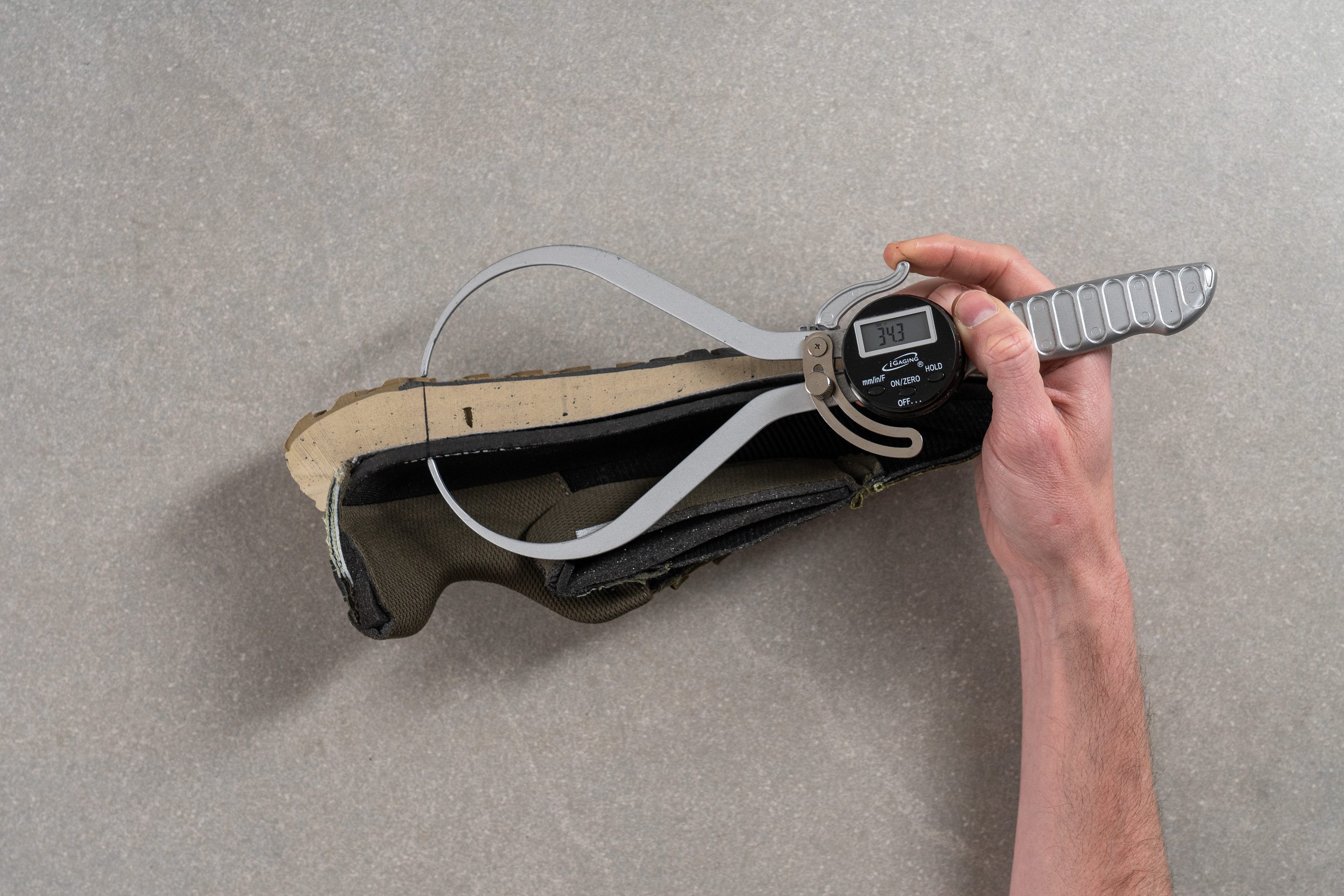
| Fly Strike | 34.3 mm |
| Average | 32.6 mm |
Forefoot stack
On the flip side, when we measured the forefoot, we were taken aback. In fact, we triple-checked the measurement due to the shockingly low number our digital calliper displayed. Just 17.0 mm including outsole and insole?
Indeed, that's the case, and visually, it's clear that the forefoot is exceptionally slim. This undoubtedly contributes to a significant heel-to-toe drop...

| Fly Strike | 17.0 mm |
| Average | 25.1 mm |
Drop
We just mentioned a "significant" heel-to-toe drop, but a 17.3 mm difference is just off the charts. And it significantly deviates from the official 10-mm drop that Merrell advertises, clearly not aligning with measurements based on World Athletics standards.
The shoe practically looks like a wedge, narrowing its appeal to those specifically looking to relieve pressure on the Achilles and calves, or for whom a sports doctor has specifically recommended an exceptionally high offset.
It's basically a niche shoe that, while it may serve its purpose for some, isn't the go-to choice for the average trail runner at all.
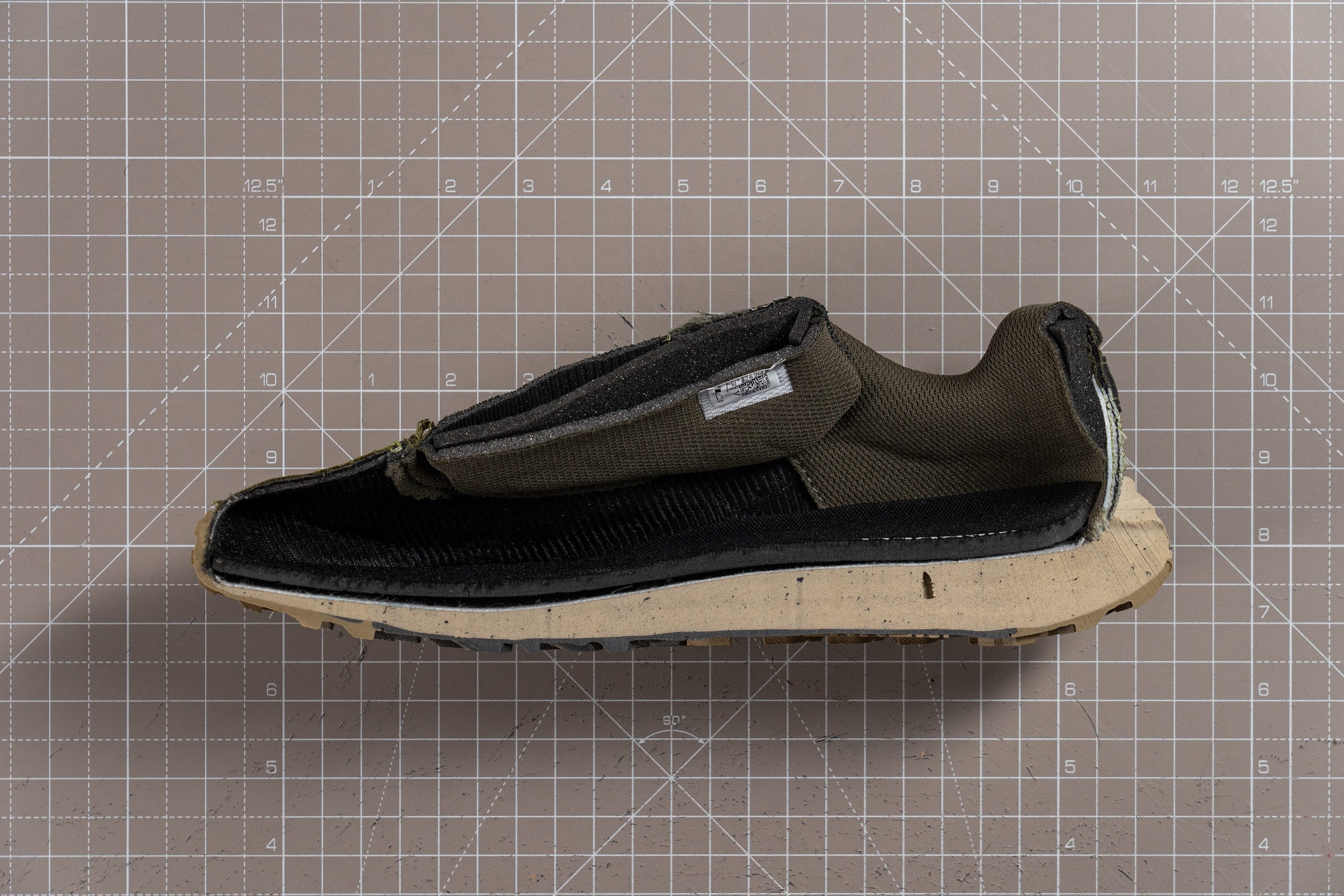
| Fly Strike | 17.3 mm |
| Average | 7.5 mm |
Midsole softness
It appears to us that Merrell just loves to create hype with names. We transitioned from the "Sticky Rubber" outsole to the "Super Rebound Compound" in the midsole.
Yet, in reality, this turns out to be standard EVA foam, lacking any distinctive features, and it falls significantly short of the ultra-responsive PEBA foams.
Despite its absence of significant energy return, we discovered its comfort to be noteworthy. We measured its softness at 20.3 HA, making it ideal for both running and walking.
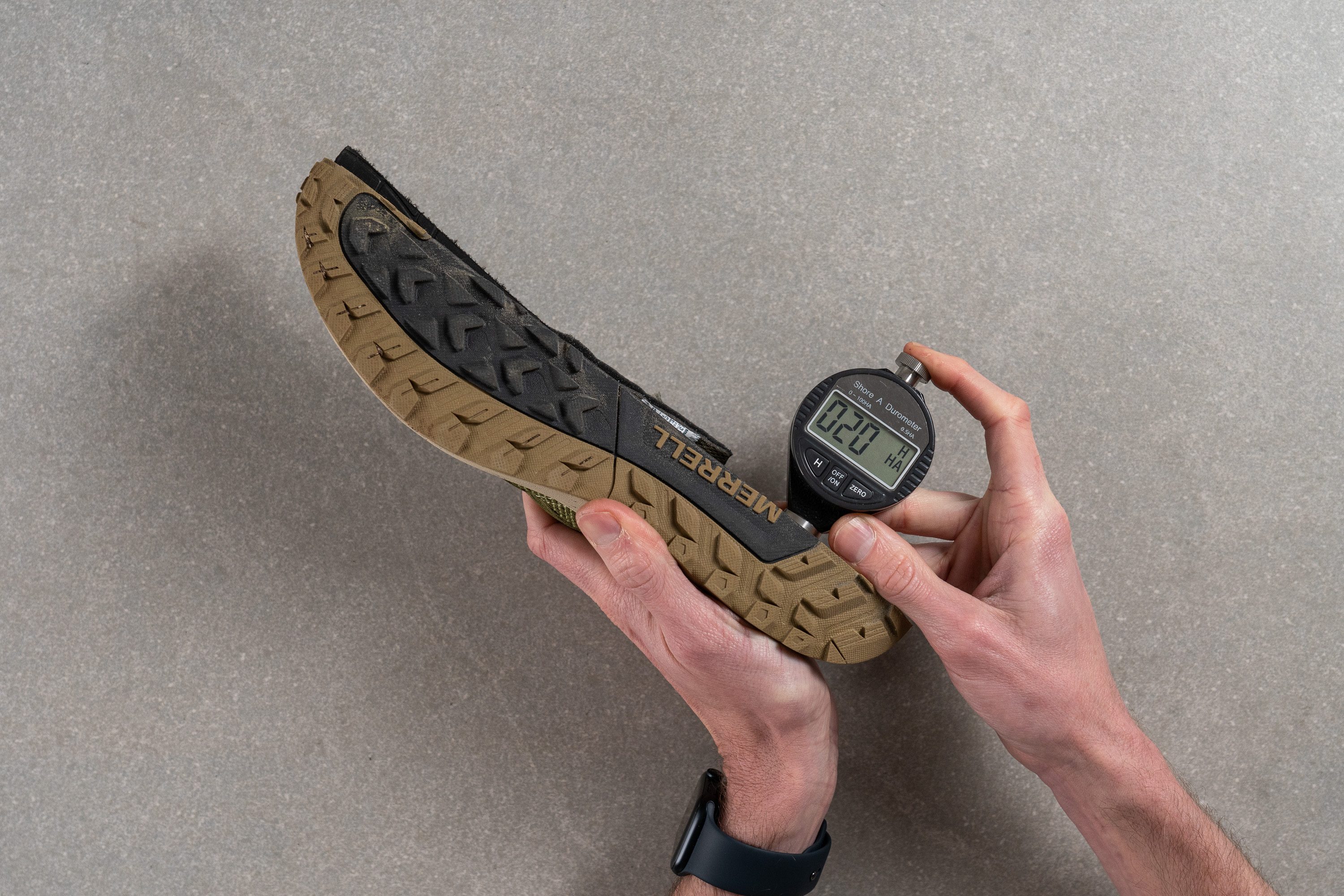
| Fly Strike | 20.3 HA |
| Average | 21.9 HA |
Size and fit
Size
Merrell Fly Strike fits true to size (52 votes).
Width / Fit
Upon our initial trial of the Fly Strike, we noted that they offered a standard fit—not too spacious nor too snug, just comfortably average. To substantiate this feel, we turned to our callipers for precision.
Measuring the upper at its widest point, we recorded a width of 98.0 mm, confirming its average dimensions.
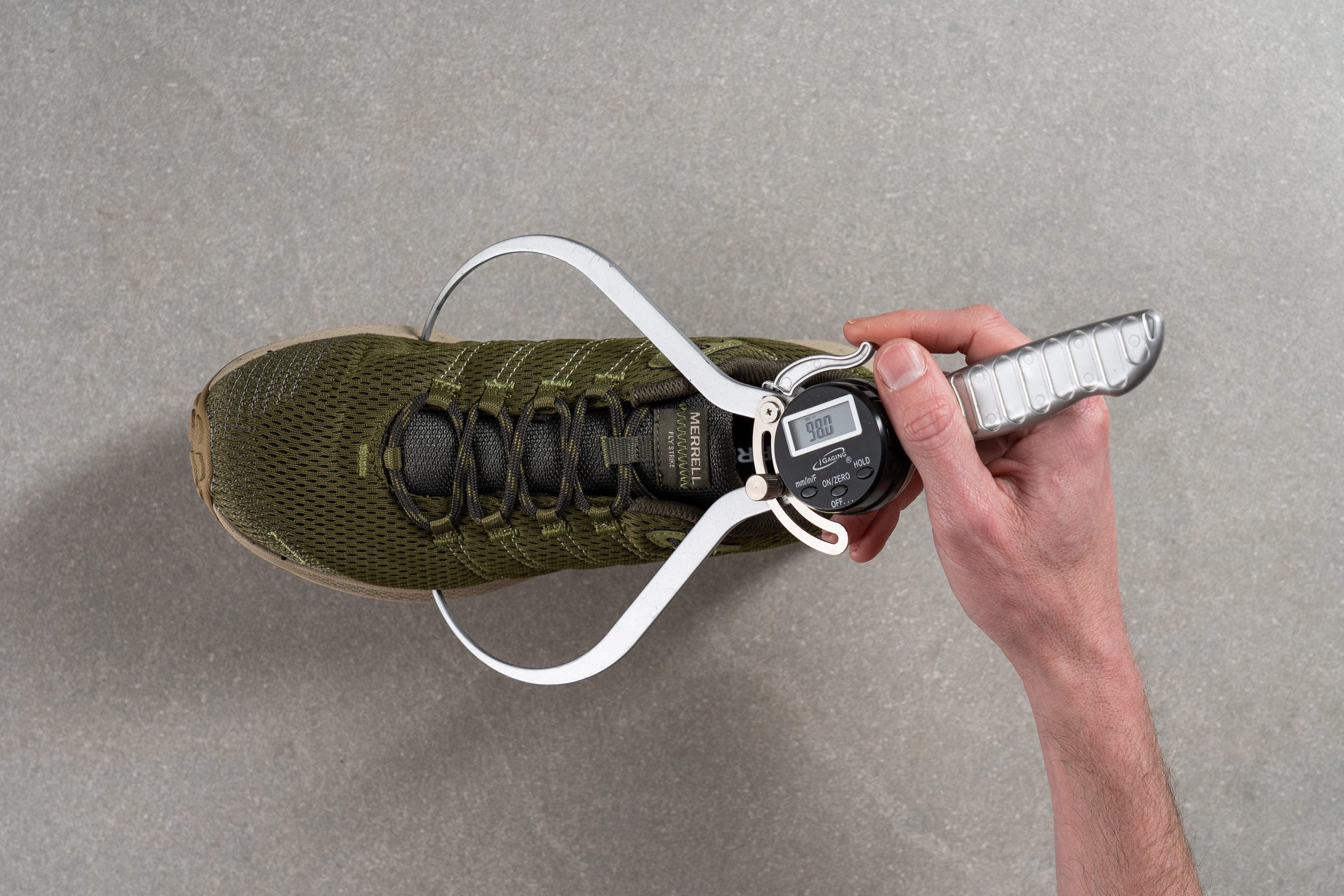
This test follows an older methodology, which is why you don't see recently tested shoes in the chart. Results from different methodologies can not be compared.
| Fly Strike | 98.0 mm |
| Average | 98.9 mm |
Toebox width
The big toe area is notably more spacious than what's found in most trail shoes, measuring at a comfortable 80.0 mm.
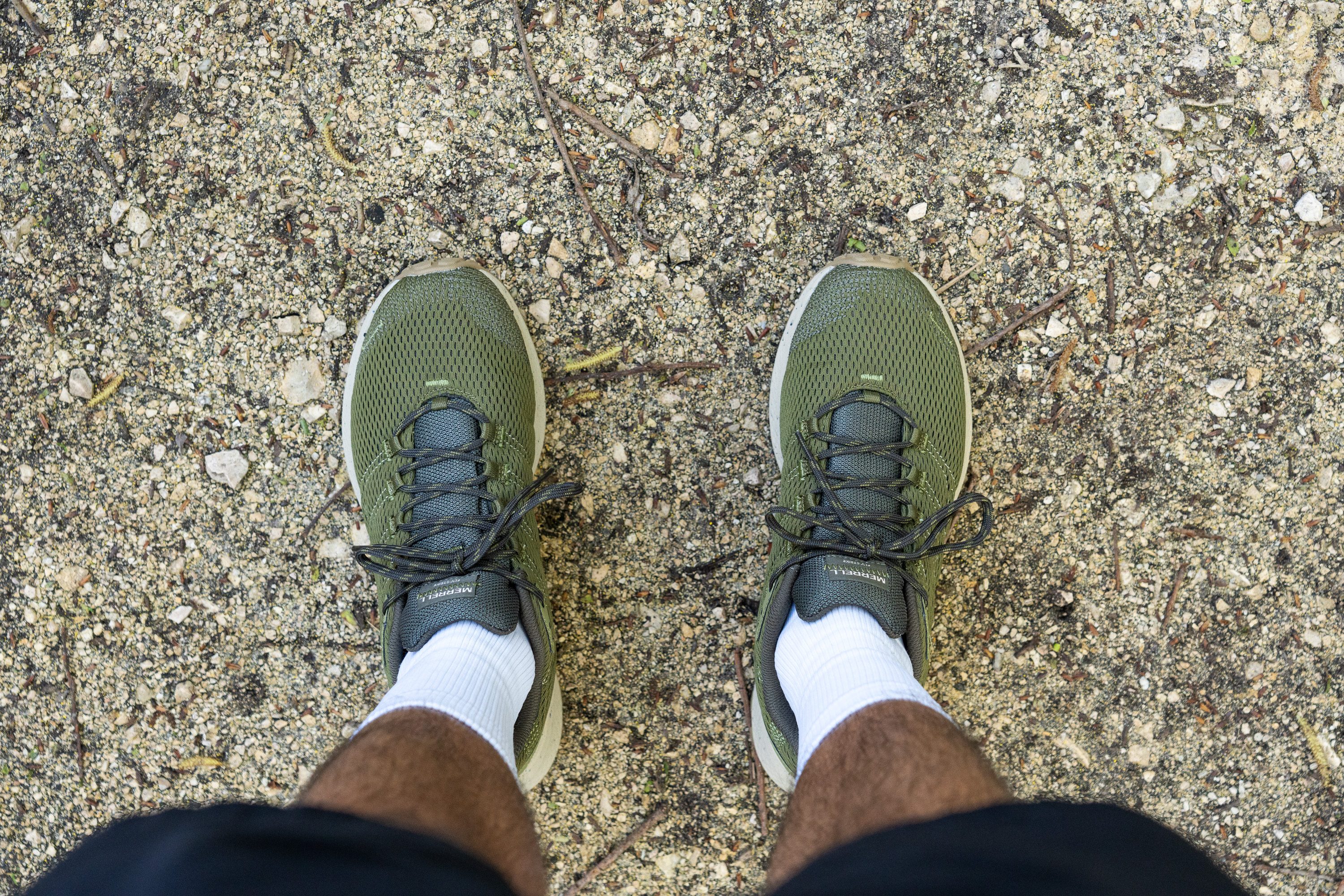
This added room is a significant advantage for those seeking a shoe versatile enough for mountain runs, extended day-long adventures, or even travel!
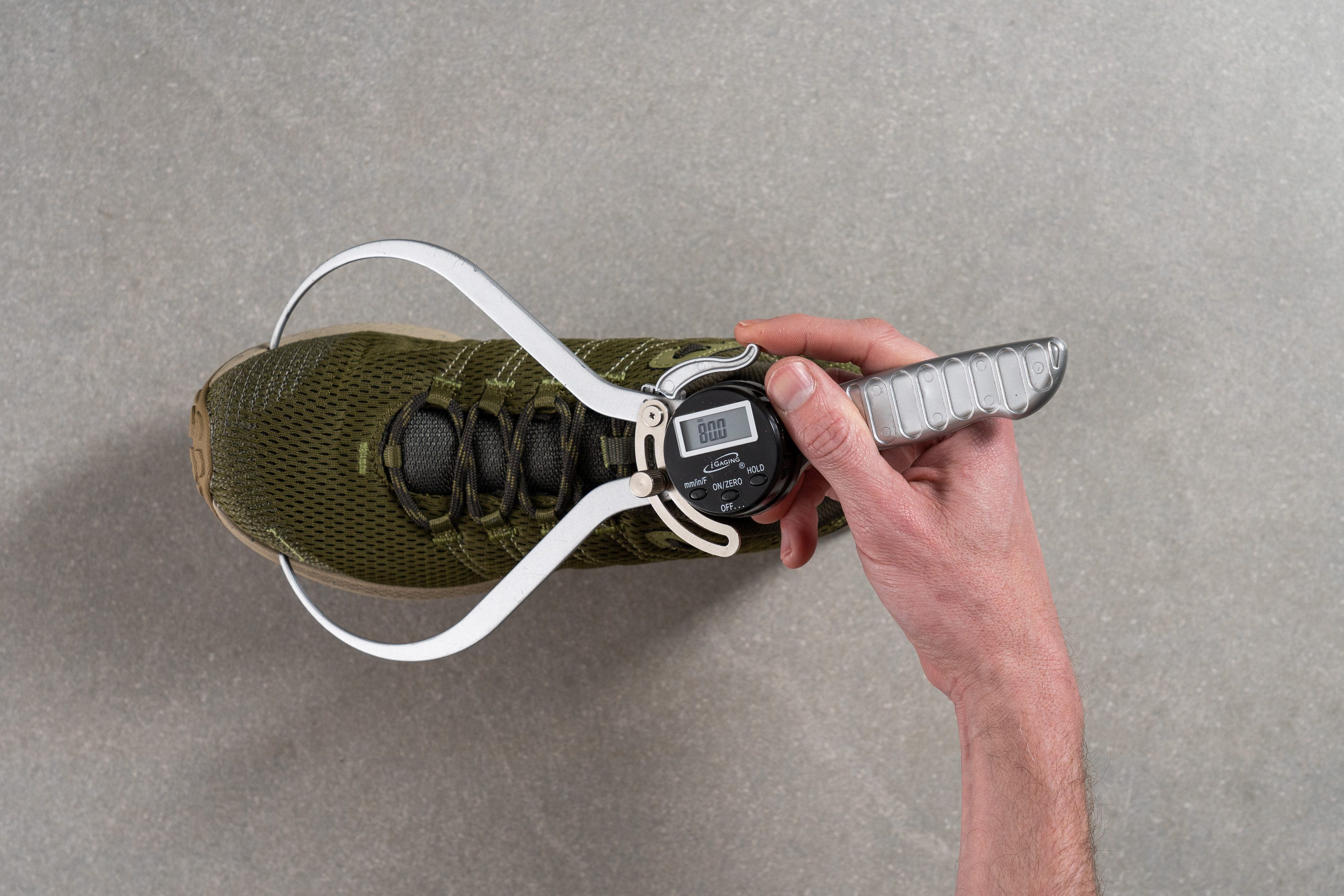
This test follows an older methodology, which is why you don't see recently tested shoes in the chart. Results from different methodologies can not be compared.
| Fly Strike | 80.0 mm |
| Average | 79.3 mm |
Traction / Grip
The tongue is exceptionally plush at 10.1 mm, boasting not just one, but two full layers of foam, ensuring a snug fit and instep comfort.
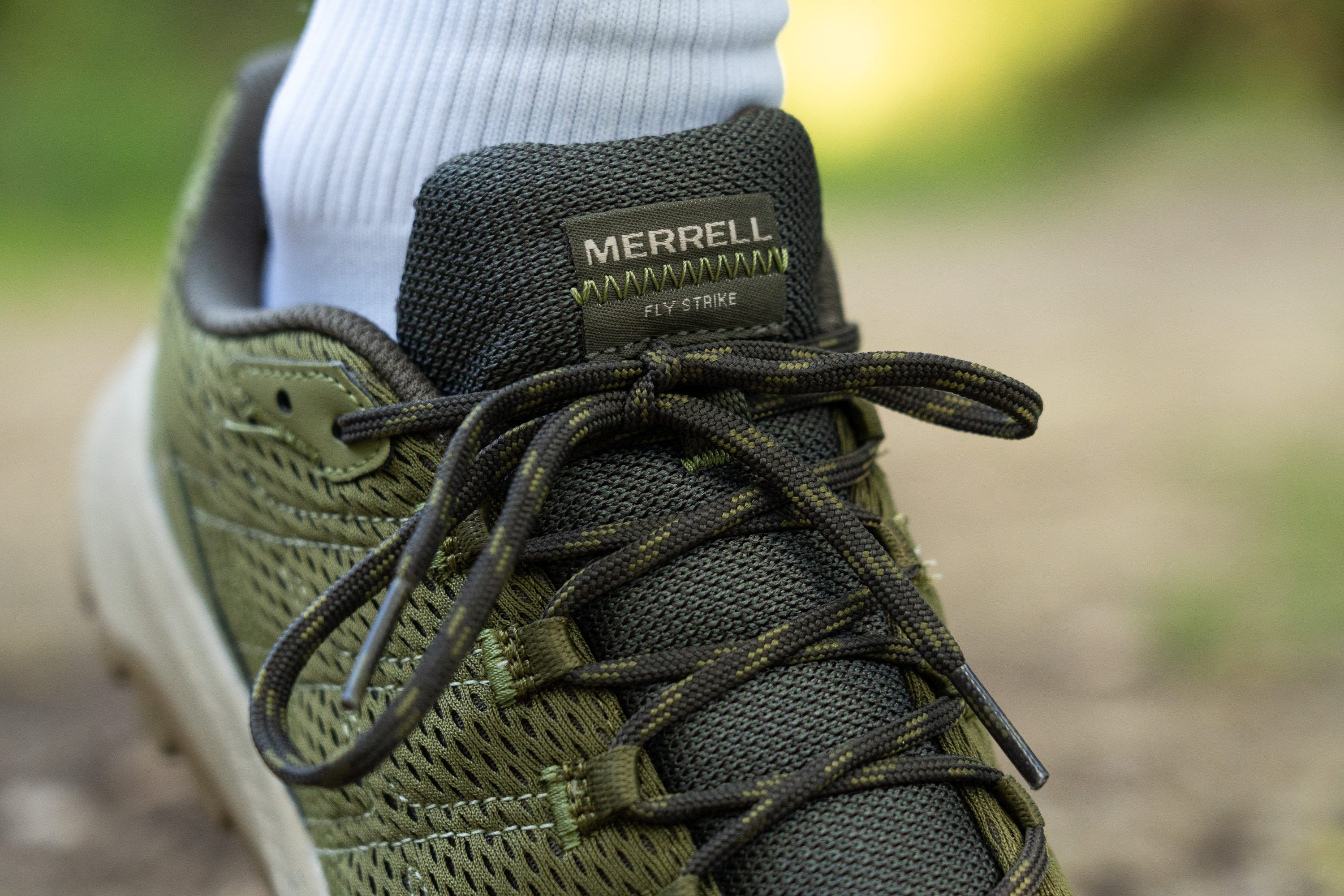
Yet, considering the shoe's hefty weight, we believe slimming down the tongue could maintain comfort while also reducing overall mass—a seemingly overlooked chance for improvement.
Lug depth
Designed as a versatile, all-terrain performer, this shoe steers clear of niche specialties like snow or highly-runnable, super-flat trails. Instead, it aims for consistent, decent performance across various terrains, with lugs of an average depth.
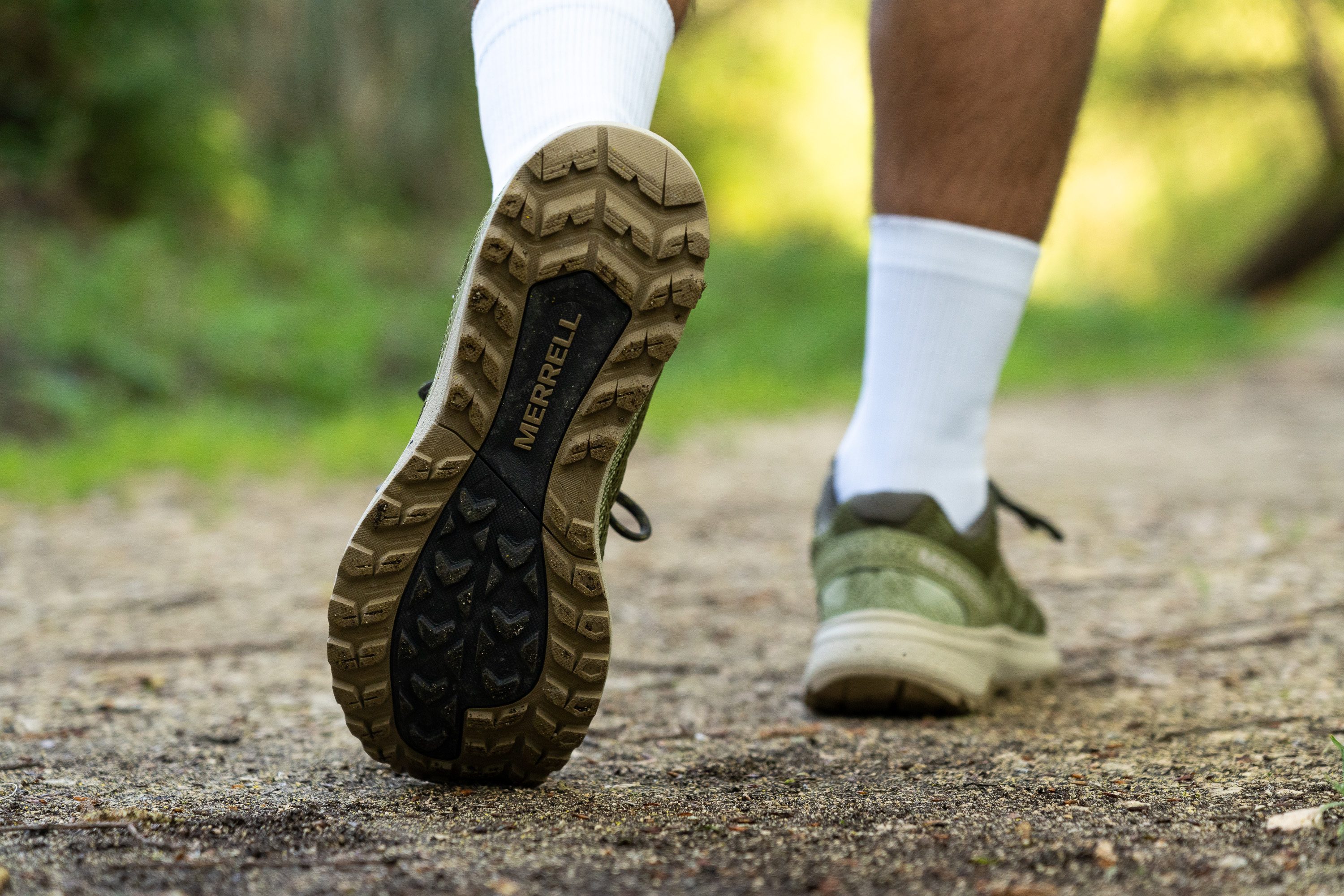
In our lab tests, we discovered that Merrell's designers embraced this approach, opting for 3.5-mm lugs.
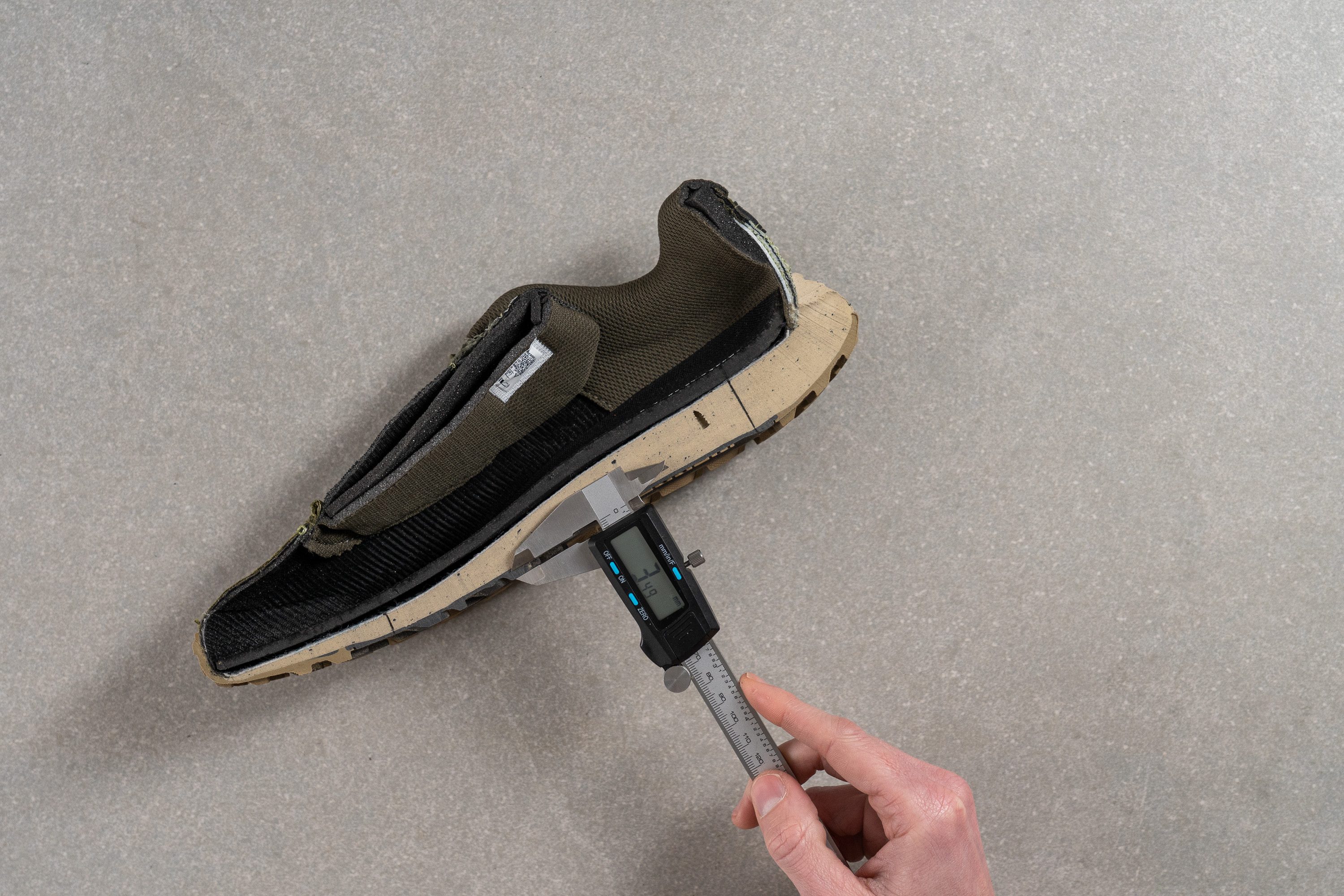
| Fly Strike | 3.5 mm |
| Average | 3.5 mm |
Flexibility / Stiffness
We were pleased to discover in our 90-degree bend test, which measures stiffness across various shoes, that the Fly Strike was remarkably flexible.
Registering at just 18.4N in our force gauge, it demonstrated excellent flexibility, making it an ideal choice for casual wear or long hikes due to its superior comfort.
This test follows an older methodology, which is why you don't see recently tested shoes in the chart. Results from different methodologies can not be compared.
| Fly Strike | 18.4N |
| Average | 27.1N |
Stiffness in cold (%)
In our second cold-temperature test, we assessed the stiffness of this Merrell model and found it increased by 23.2%. That's a decent outcome, particularly for a shoe that isn't positioned as a high-cost option in the market.
| Fly Strike | 23% |
| Average | 32% |
Weight
Weighing in at 10.3 oz or 292g, this shoe strikes a good balance, yet we found it feels a bit bottom-heavy in our field tests, due to the lack of forefoot cushioning.
It seems to us that this might be the reason Merrell decided against adding extra outsole thickness—tipping the scale beyond 10.5 oz was likely deemed too hefty.
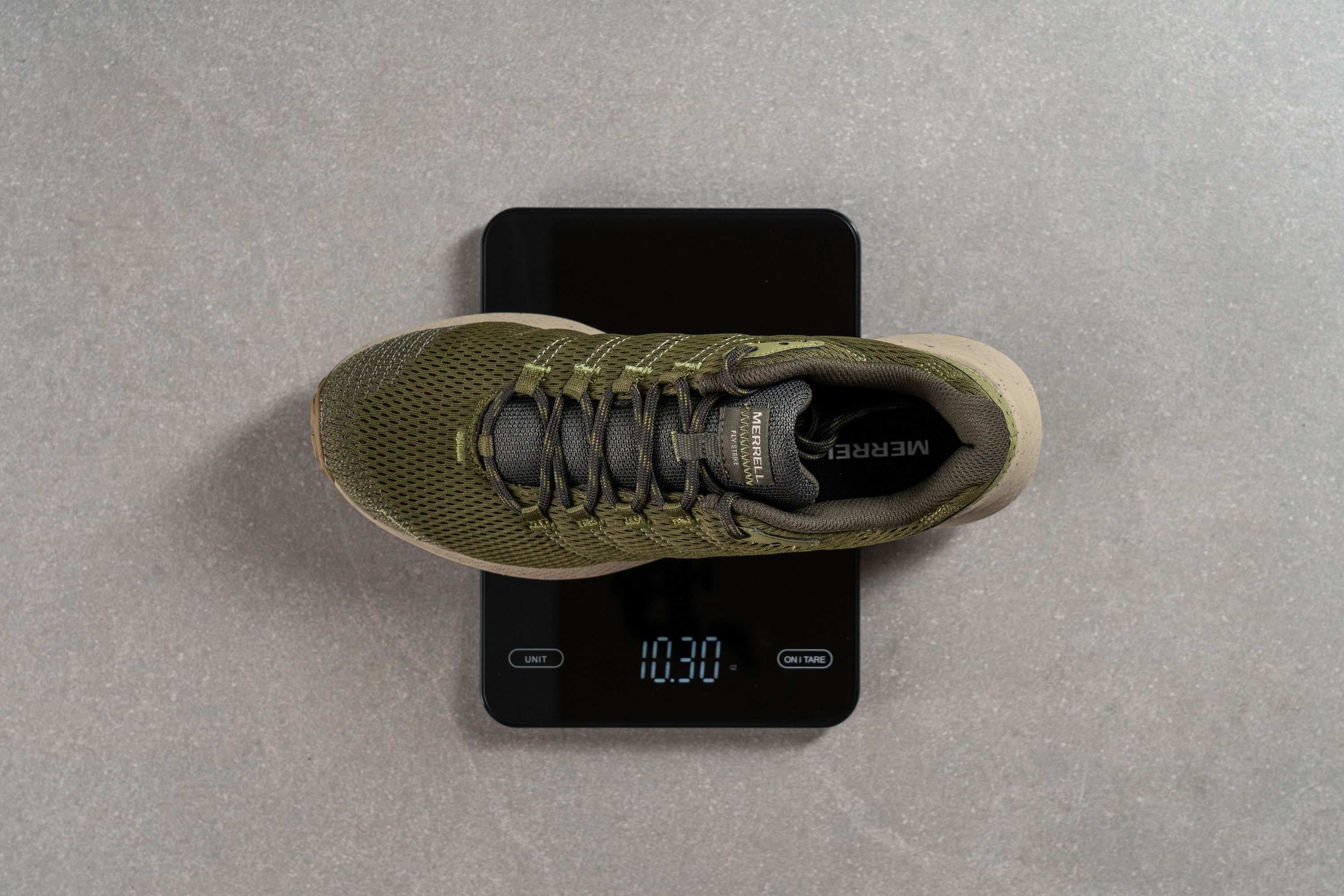
| Fly Strike | 10.3 oz (292g) |
| Average | 10.2 oz (289g) |
Breathability
The Merrell Fly Strike's engineered mesh doesn't have some ventilation holes in the toebox like many other trail shoes—instead, it's packed with them all over! This unique design led us to anticipate positive results in our smoke-pumping test.
Indeed, our lab testing awarded the Fly Strike a 4/5 rating, outshining the average trail running shoe and making it a top pick for summer adventures, both hiking or running.
You might wonder why Merrell opted for this design. Our light test shed light (no pun intended!) on this mystery. Despite the mesh, no light passed through the upper, revealing the necessity for all-around breathability.
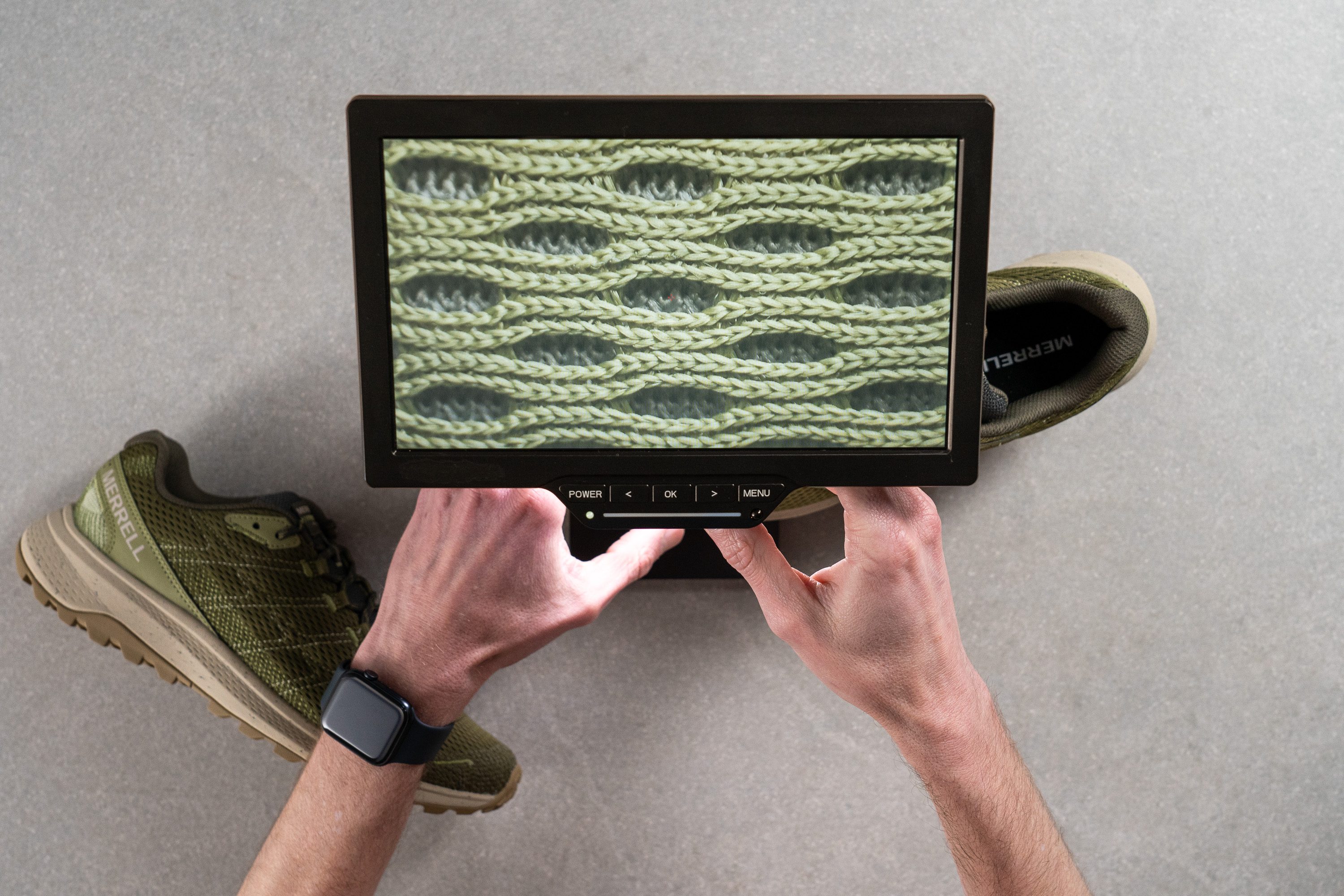
Diving into the details of these tiny ventilation holes with our lab microscope was fascinating.
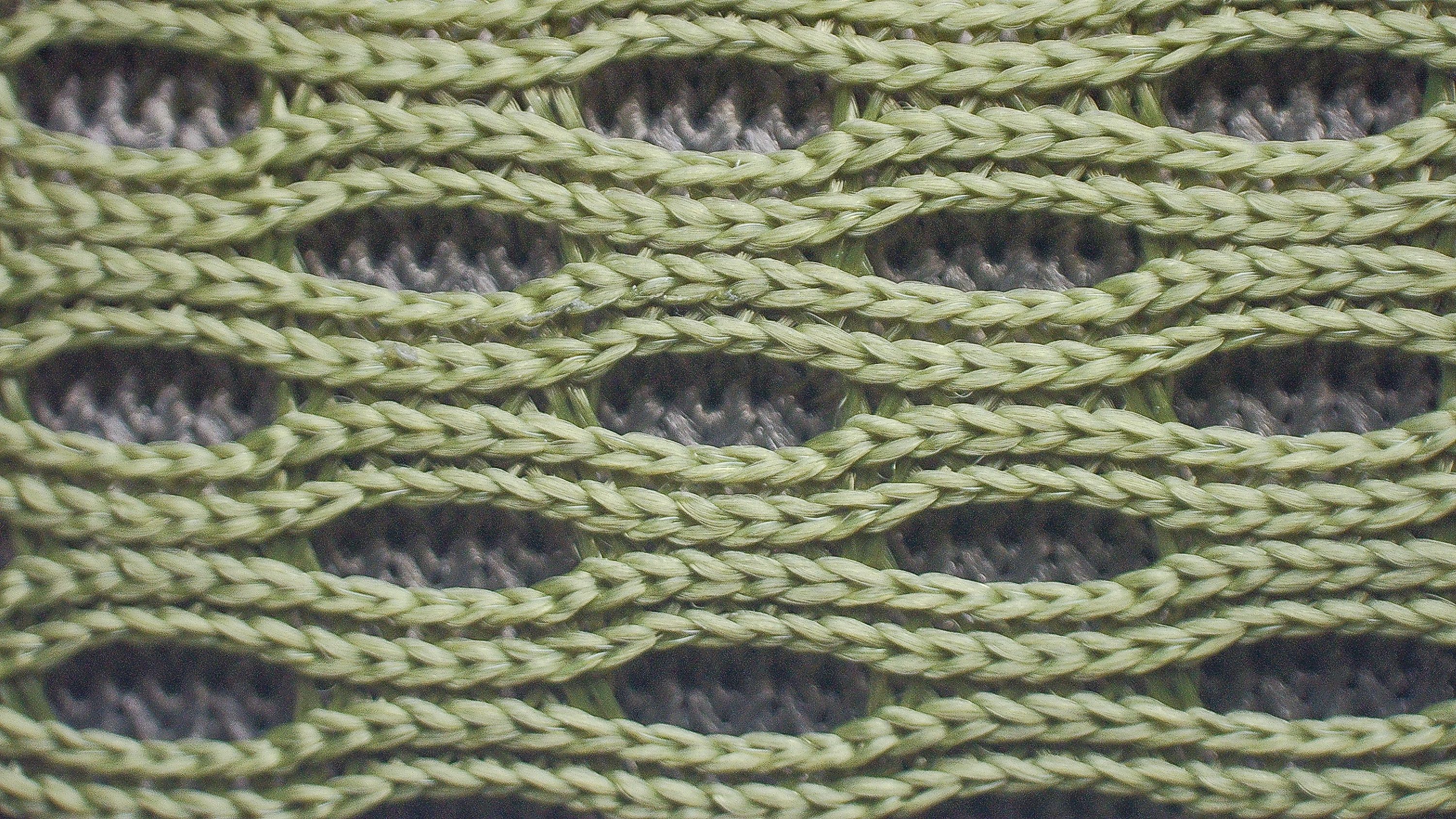
The mesh features a primary green layer with consistent openings, underlaid by a thinner fabric that reduces airflow just a bit. This design is actually beneficial for a trail shoe, enhancing durability without significantly compromising breathability.
We're actually impressed by Merrell's ability to craft such a well-ventilated upper in a shoe that doesn't skimp on padding!
| Fly Strike | 4 |
| Average | 3.2 |
Stability
Lateral stability test
The Fly Strike, designed as a neutral trail running shoe, offers just a hint of stability. However, for trail runners seeking substantial support, we can't recommend it.
For those needing enhanced stability combined with a high-drop design, the Salomon XA Pro 3D v9 is a more suitable choice.
Torsional rigidity
The slight stability we noted in our test runs largely stems from the shoe's rigidity. In our hands-on evaluation, we rated it a 4/5, making it notably rigid for a trail shoe and potentially uncomfortable to some.
| Fly Strike | 4 |
| Average | 3.6 |
Heel counter stiffness
The heel counter strikes a great balance, effectively enveloping the rearfoot to eliminate any heel slippage. We gave it a solid rating of 3/5 for its stiffness.
| Fly Strike | 3 |
| Average | 3 |
Midsole width - forefoot
Following our previous experiments, we grabbed the callipers again to measure the midsole dimensions.
Beginning with the forefoot, our initial reading showed a 110.8 mm width, which aligns well with the average and further positions the shoe as suitable only for neutral runners. We also believe this design choice is optimal for a shoe striving for high versatility in terms of terrain.
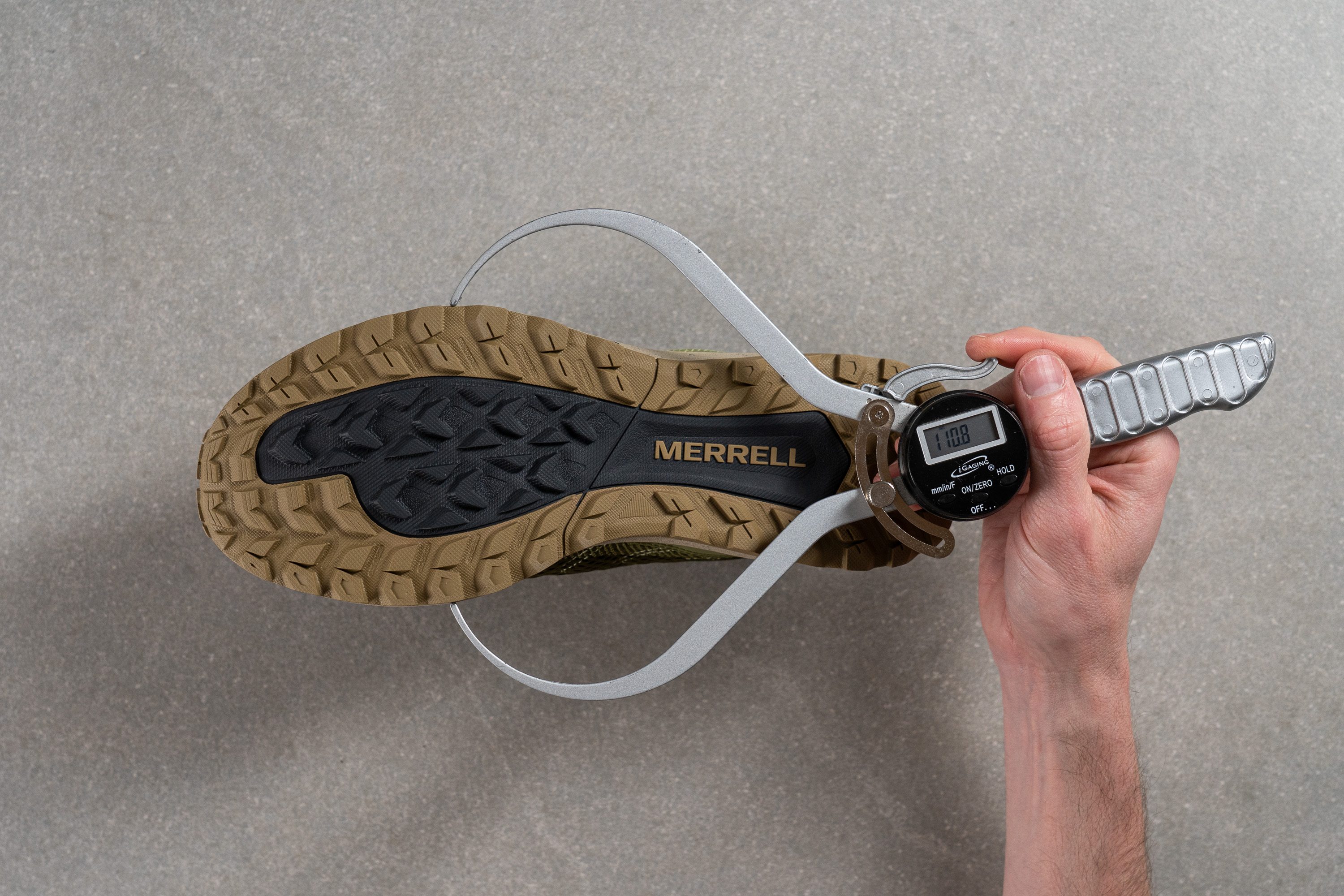
| Fly Strike | 110.8 mm |
| Average | 112.8 mm |
Midsole width - heel
Shifting our focus to the heel, we encountered a surprising discovery—measuring at just 83.9 mm, it's really narrow for a shoe that's ostensibly designed for heel strikers.
This stark narrowness serves as definitive evidence that neutral heel landing is crucial to enjoy this shoe.
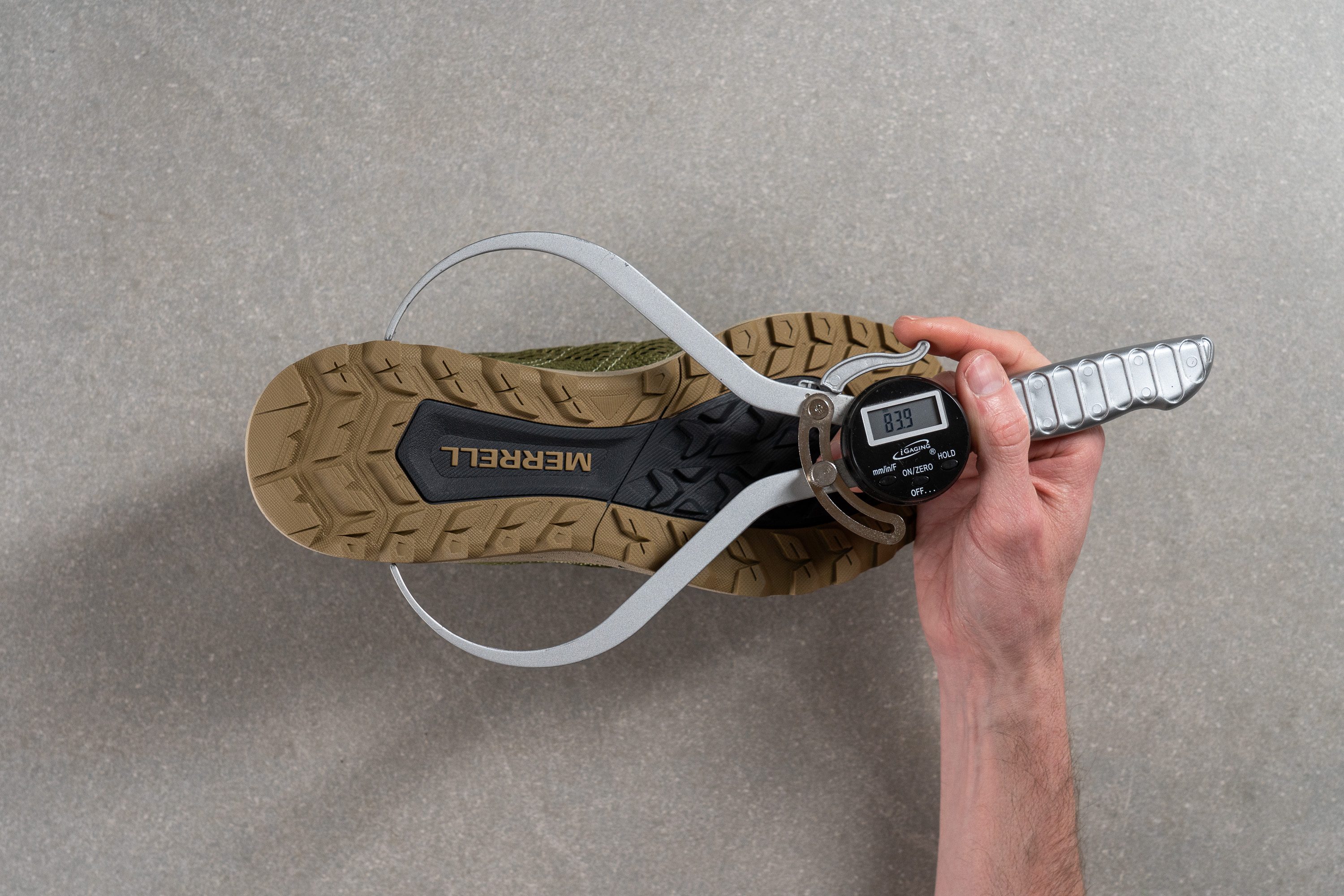
| Fly Strike | 83.9 mm |
| Average | 89.9 mm |
Durability
Toebox durability
We've found in the lab that uppers crafted from engineered mesh with consistent ventilation often don't fare well in durability tests. That's why we were eager to see how this one would hold up under our Dremel tool. Let's go for it!
After putting it to the test, we were thrilled to report minimal damage—a remarkable achievement that earned a stellar 4/5 score.
This impressive result came even though the Dremel was applied to an unprotected area. However, it's worth noting that Merrell has reinforced the toe cap for added durability, but since we maintain consistency in testing by applying the tool to the same spot on every shoe, this one faced the challenge on its bare mesh and still performed really well.
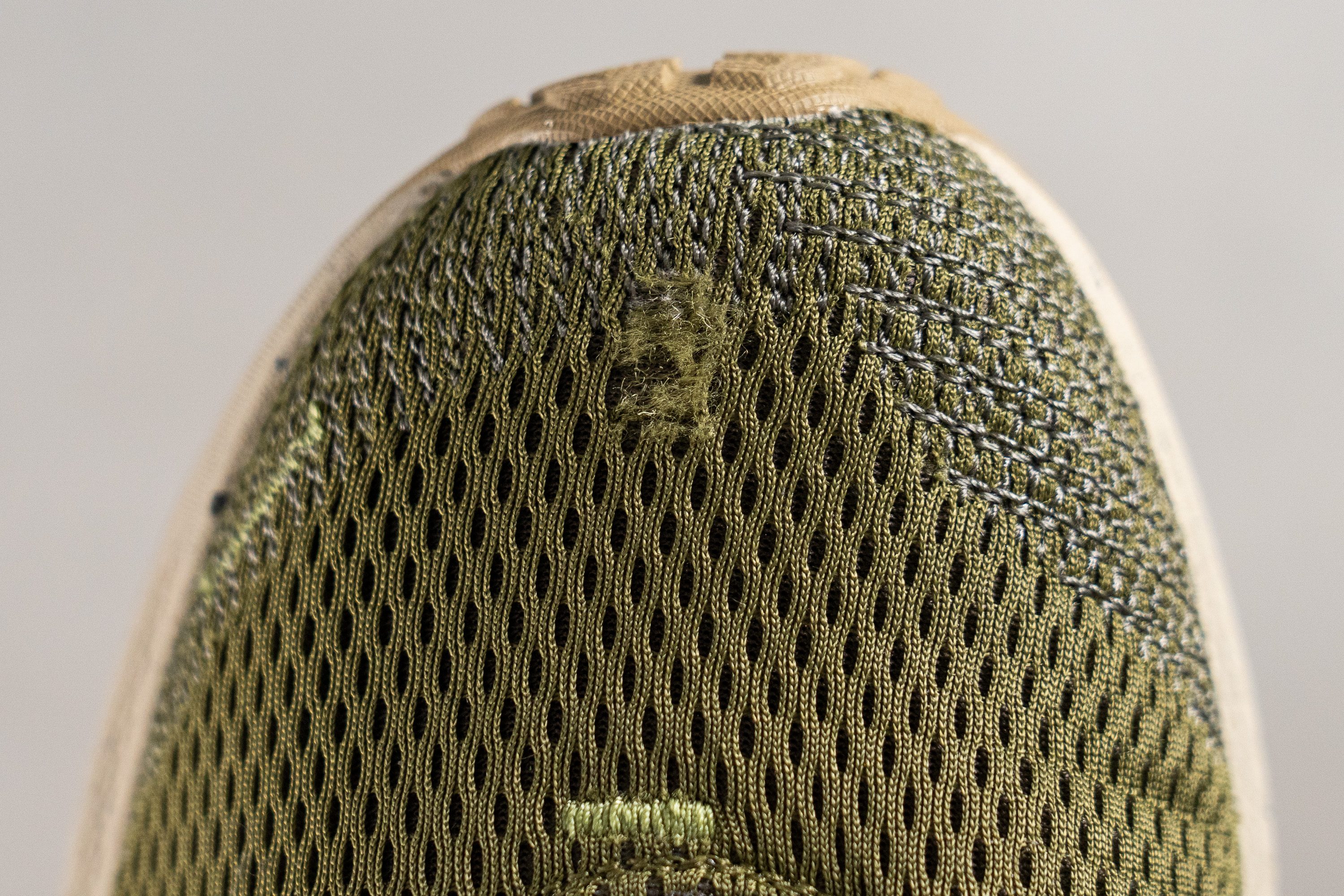
| Fly Strike | 4 |
| Average | 3.1 |
Heel padding durability
Buoyed by such encouraging results, we proceeded to examine the shoe's heel padding, applying the same Dremel settings used previously.
Though the outcome was slightly lower than the toebox's impressive performance, a score of 3/5 is still deemed quite respectable here in our lab. From our standpoint, it's clear that the majority of runners will find the heel padding durability more than adequate, presenting no issues at all during the whole shelf life of the shoe.
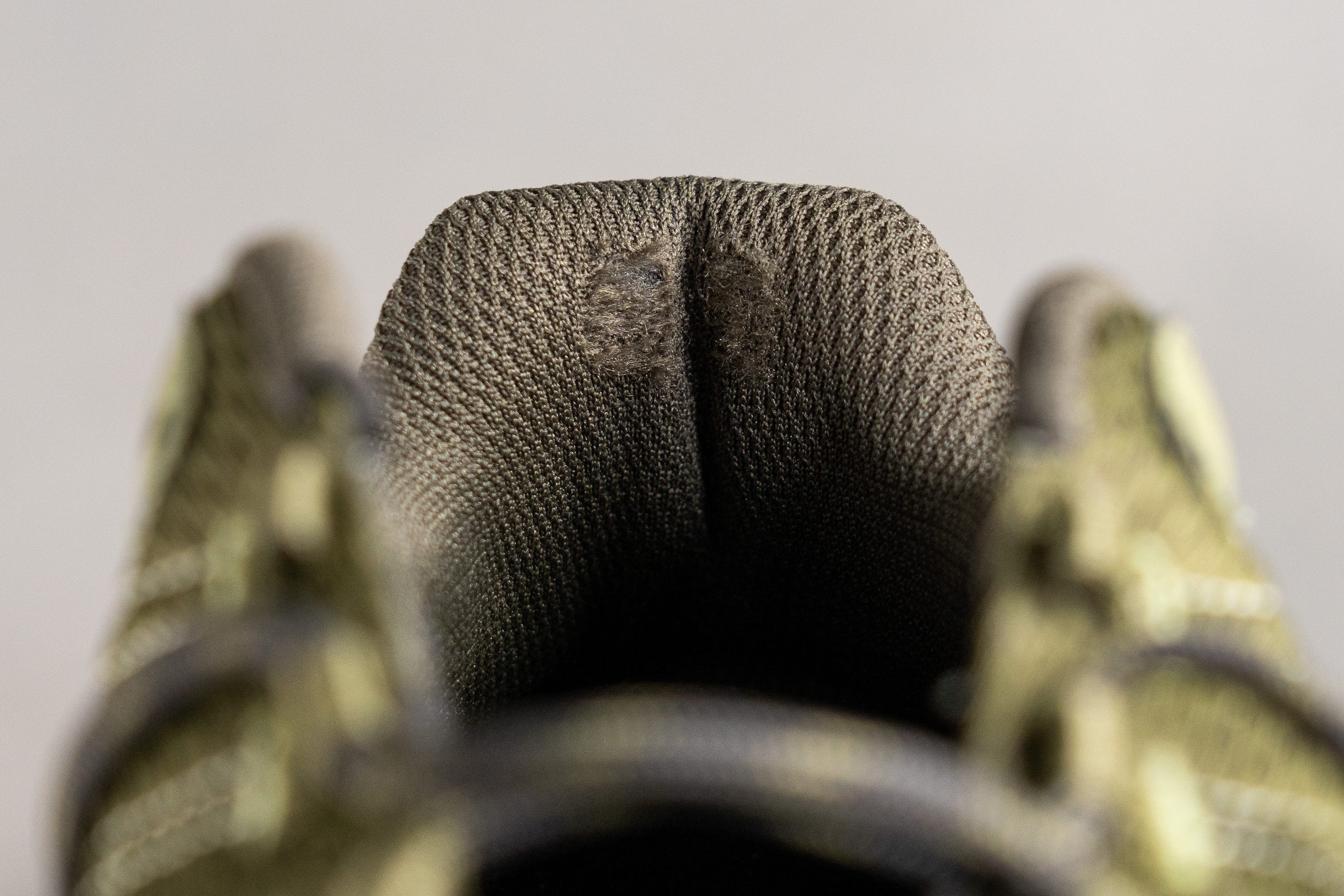
| Fly Strike | 3 |
| Average | 3 |
Outsole hardness
The outsole is arguably the most crucial component of any trail shoe, so we were eager to put the Fly Strike's outsole to the test in our lab.
Our initial step was to measure the hardness of the Sticky Rubber material, which registered a solid 89.0 HC. This finding is consistent with our hands-on experience—the grip is decent, but it doesn't quite live up to the "sticky" expectation.
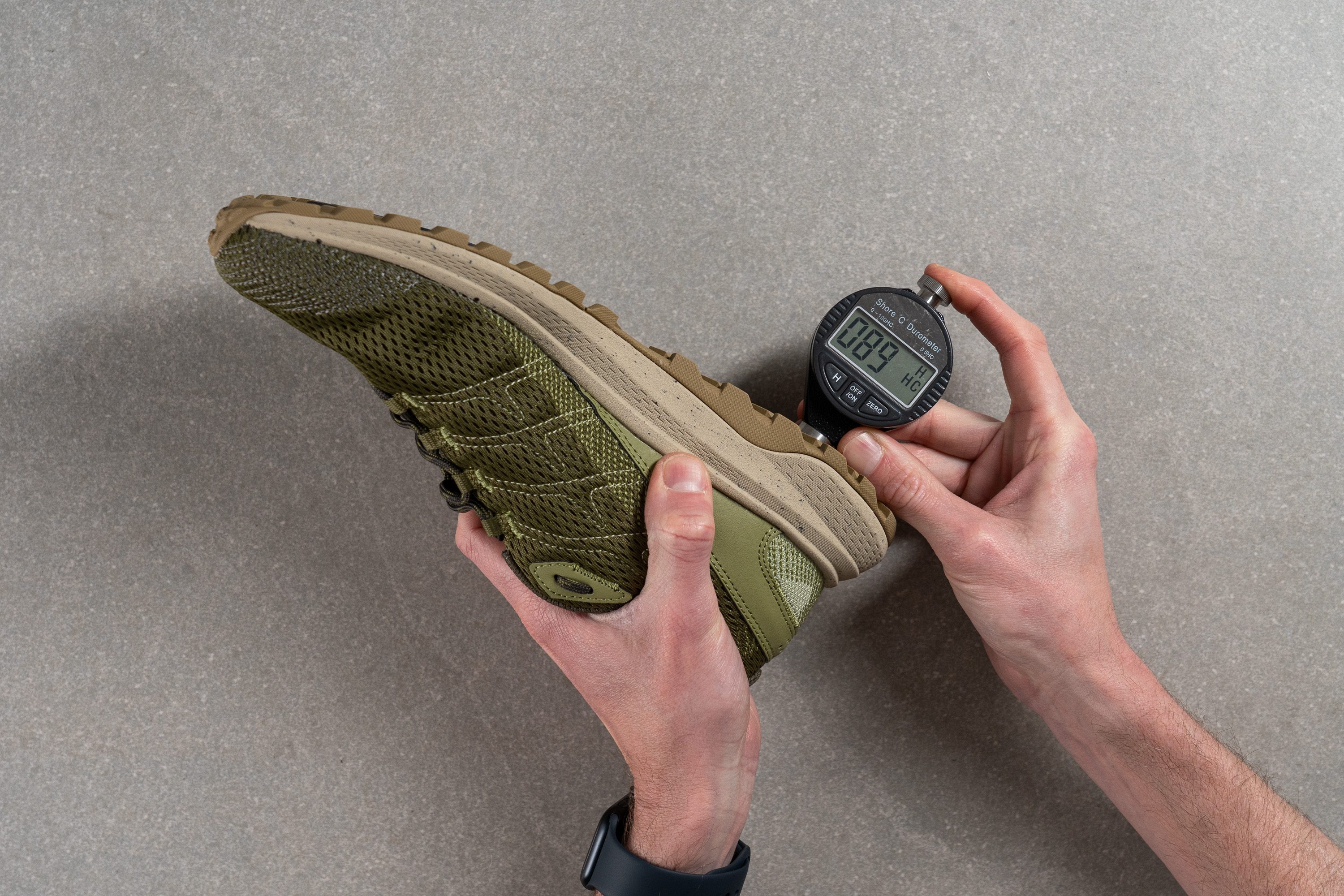
| Fly Strike | 89.0 HC |
| Average | 85.8 HC |
Outsole durability
We were frankly disappointed when our Dremel test resulted in a 1.2-mm indentation on the outsole.
Given the previous hardness measurement of 89.0 HC, we expected a much more resilient performance. While the outcome wasn't catastrophic, it's clear to us that there's significant room for improvement in the durability of future versions of the Fly Strike.
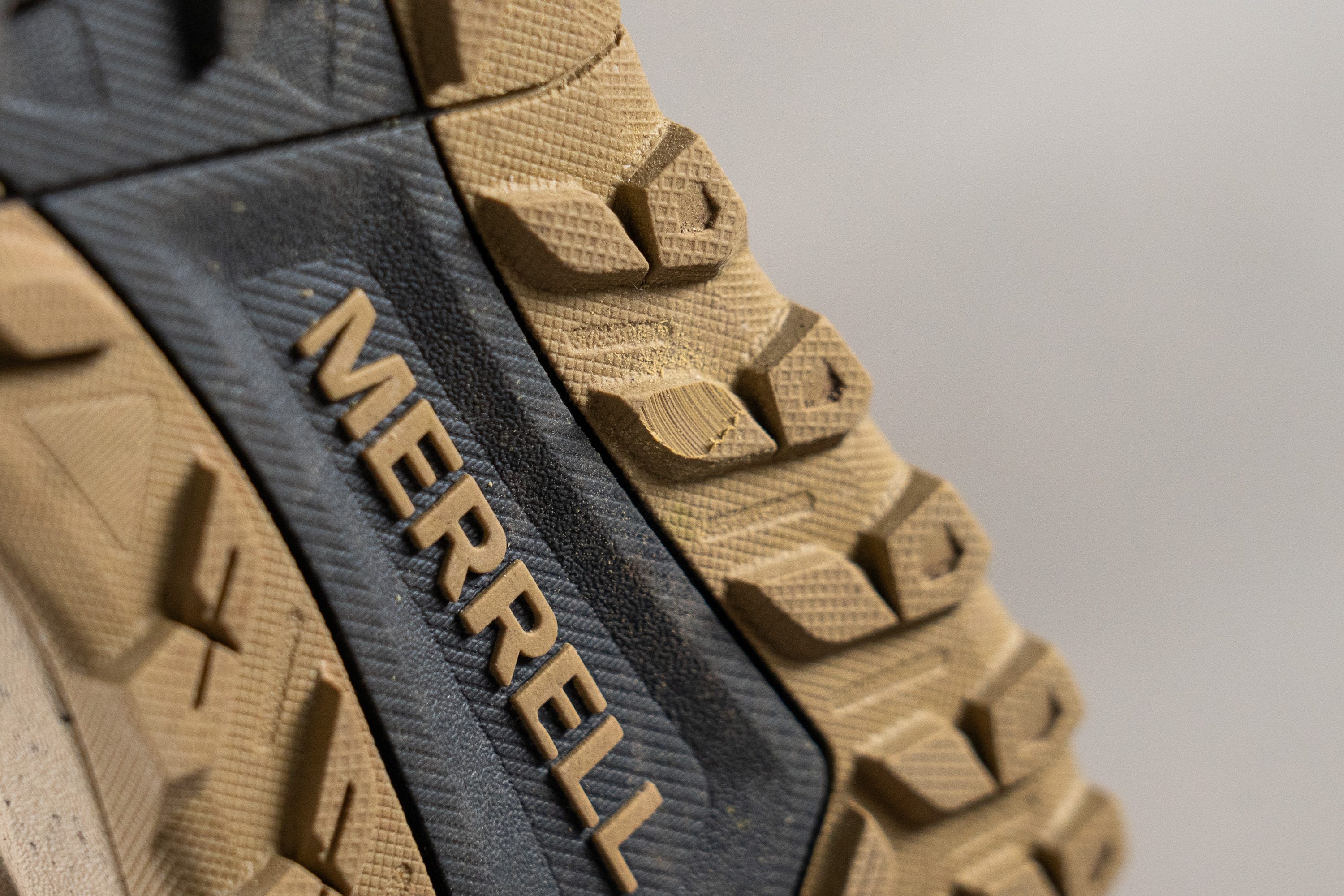
| Fly Strike | 1.2 mm |
| Average | 0.9 mm |
Outsole thickness
It's worth mentioning that the Fly Strike offers a mere 1.8 mm of rubber between the midsole and the lugs, landing it on the thinner side for protection.

This is particularly noteworthy because it lacks a rock plate, potentially leaving the underfoot more vulnerable on rugged trails.

| Fly Strike | 1.8 mm |
| Average | 2.2 mm |
Misc
Insole thickness
The insole boasts a plush 6.4 mm of cushioning, which truly stands out, particularly when walking.
This added layer brings much-needed comfort to the forefoot area, which, as we recently highlighted, is notably lacking in foam.
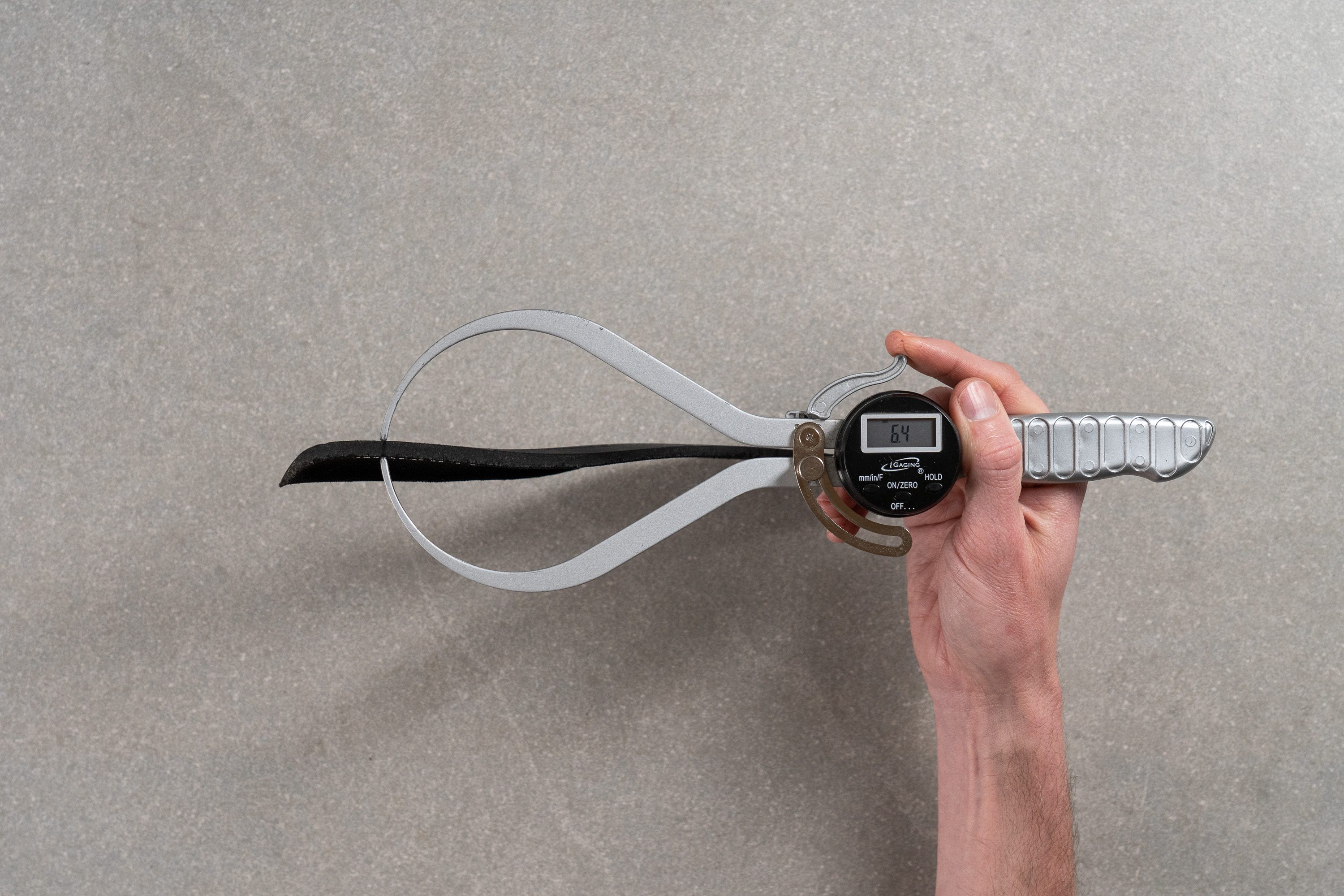
| Fly Strike | 6.4 mm |
| Average | 4.7 mm |
Removable insole
As we previously mentioned, the insole is notably thick.
Because it's not glued, we found that you can take it out and allow for the easy incorporation of almost any third-party orthotic or even slimmer footbeds from other shoes, creating extra room in the toebox if needed.

| Fly Strike | Yes |
Midsole softness in cold (%)
We placed the Fly Strike in the freezer for 20 minutes to test its softness in cold conditions and were truly impressed by its performance—it hardened by only 7.4%!
This remarkable result suggests that you'll hardly notice any change in the shoe's softness during winter runs, maintaining a consistent experience.
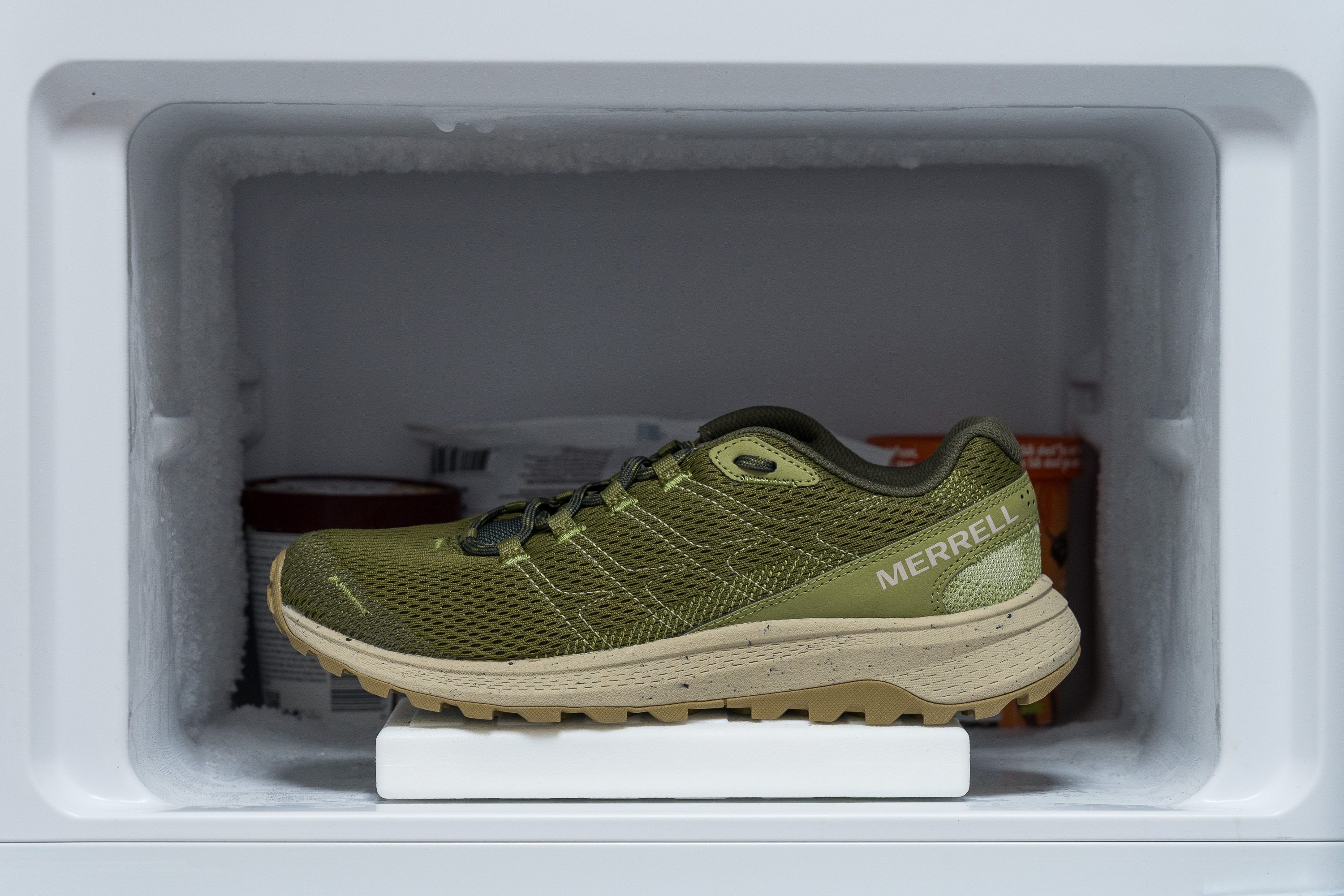
| Fly Strike | 7% |
| Average | 26% |
Reflective elements
Unfortunately, our search for reflective elements on the Fly Strike came up empty. However, considering its budget-friendly price tag, we find this omission understandable and not a deal-breaker at all.
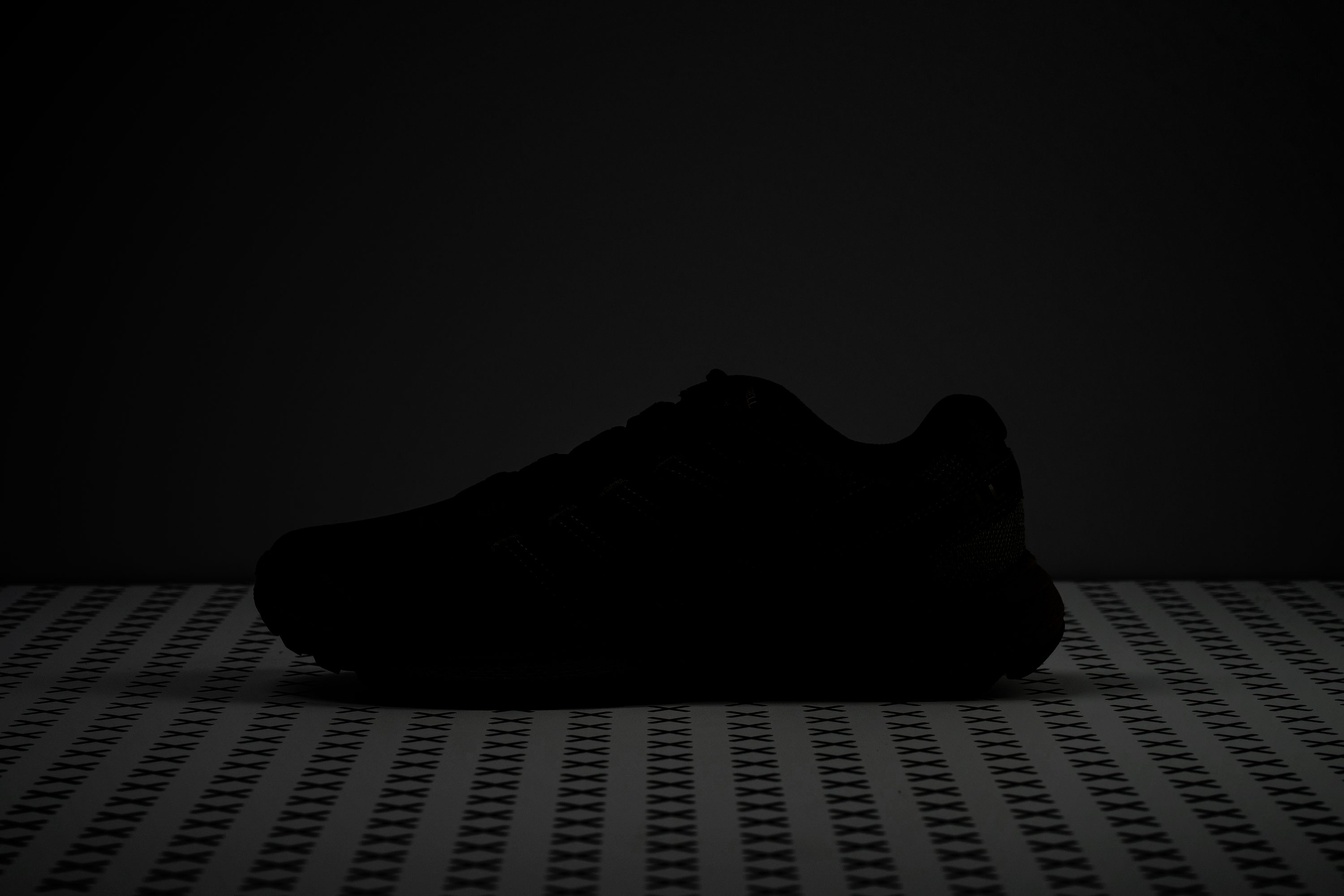
| Fly Strike | No |
Tongue padding
The tongue is exceptionally plush at 10.1 mm, boasting not just one, but two full layers of foam, ensuring a snug fit and instep comfort.

Yet, considering the shoe's hefty weight, we believe slimming down the tongue could maintain comfort while also reducing overall mass—a seemingly overlooked chance for improvement.

| Fly Strike | 10.1 mm |
| Average | 6.4 mm |
Tongue: gusset type
The tongue's free movement, due to not being attached to the sides, is a something we didn't appreciate, particularly because it could allow debris to enter the shoe.
While we understand this is a budget-friendly option and our expectations were tempered, the compromise on this feature is a letdown we had anticipated yet hoped to avoid!
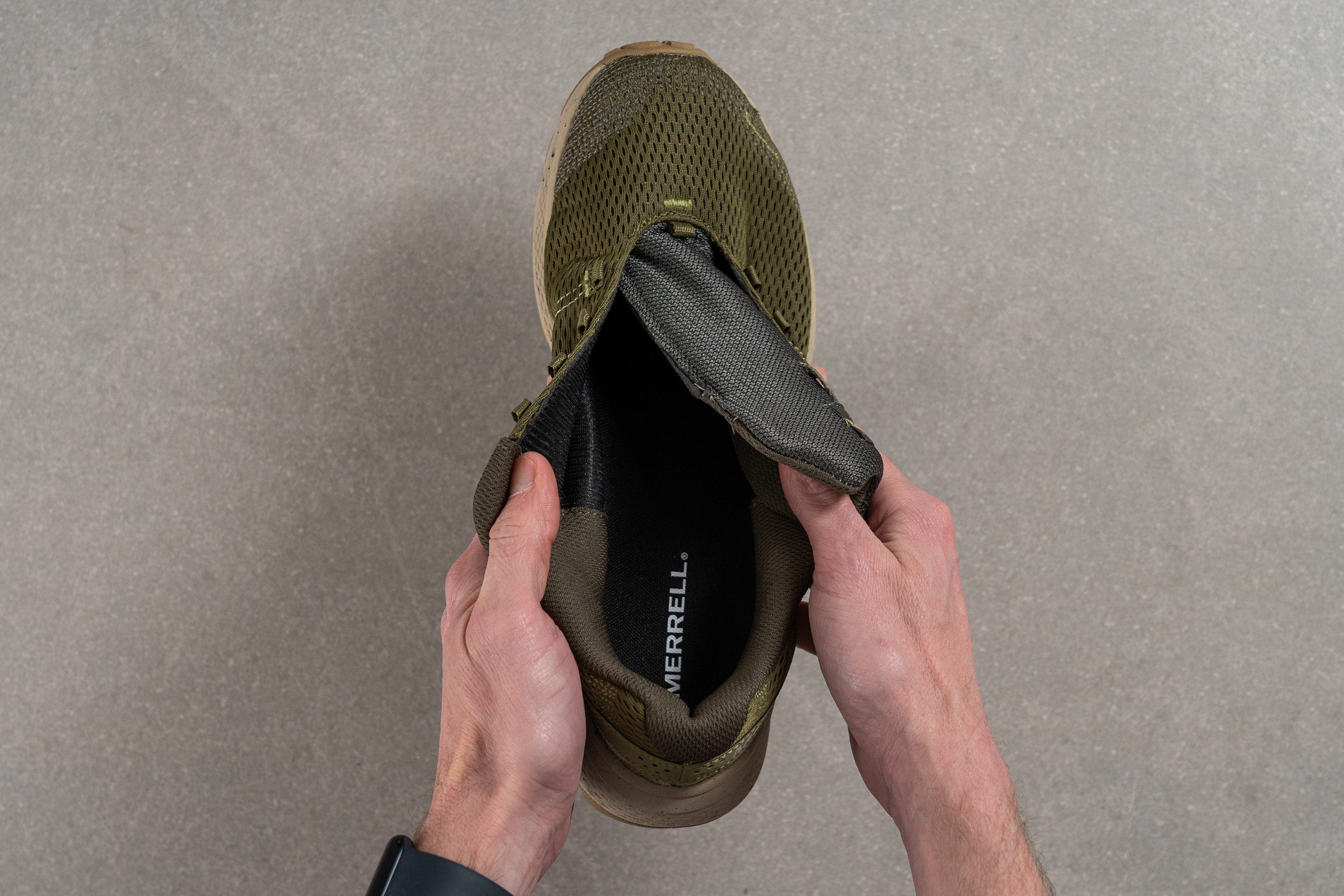
| Fly Strike | None |
Heel tab
The heel design is quite simple and doesn't include a pull tab, yet it compensates with a notably well-cushioned area.
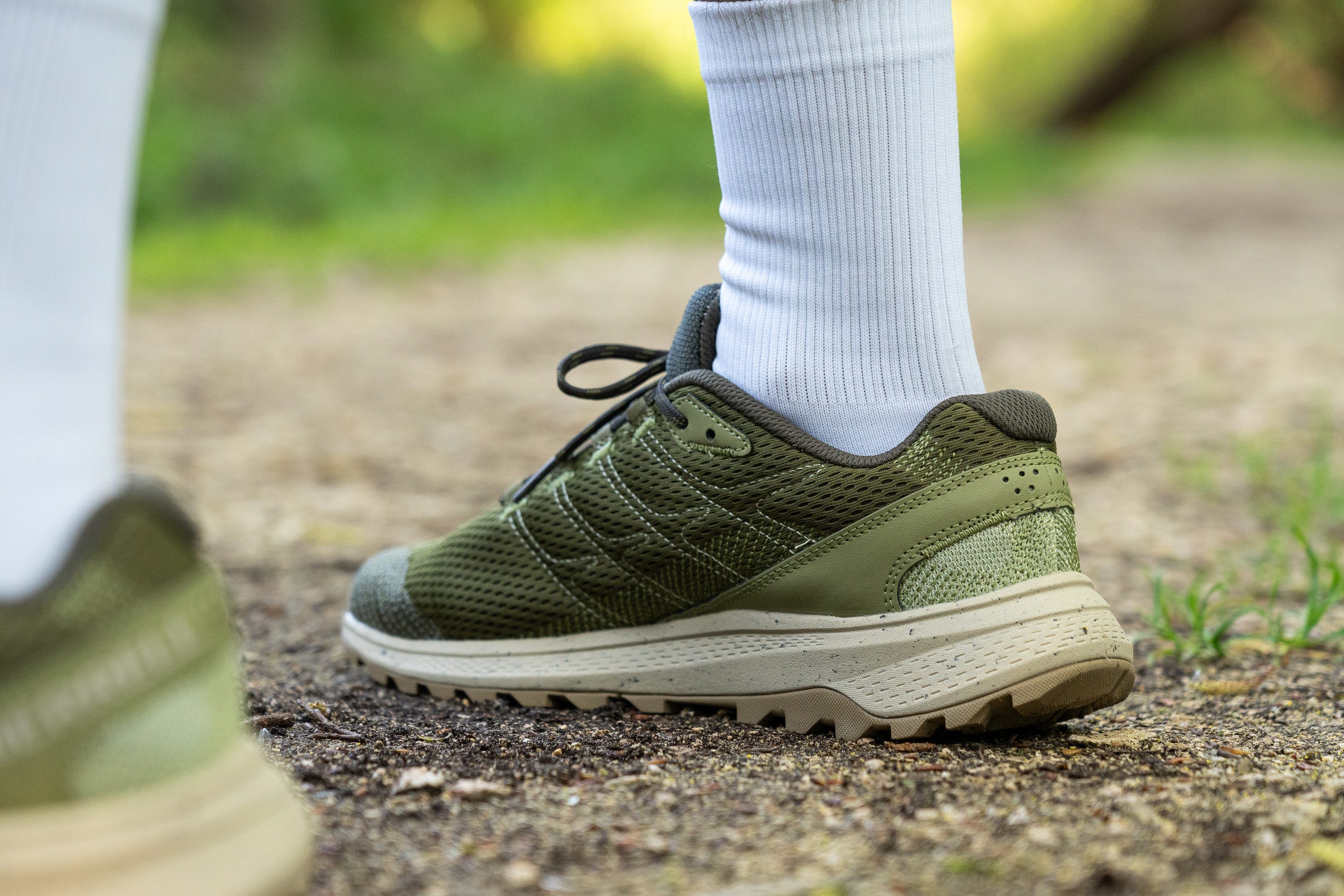
| Fly Strike | None |

